Vol. 70, No. 3 (2021)
2021-02-05
INVITED REVIEW

INVITED REVIEW
2021, 70 (3): 034206.
doi: 10.7498/aps.70.20201683
Abstract +
Widely employed in fundamental research, industrial processing, and biomedicine, femtosecond fiber lasers exhibit many attractive features such as high average power, good heat dissipation, excellent beam quality, and compact footprint. Coherent combining technology can effectively suppress the detrimental nonlinear and thermal effects in the fiber amplifiers, and therefore further increase the output pulse energy and average power of femtosecond fiber lasers. In this article, we mainly discuss different coherent combining techniques in high-power ultrafast Yb-fiber laser systems and the relevant phase-locking methods. We believe that the advent of new coherent combining techniques will further improve the average power and pulse energy of femtosecond fiber laser systems, thereby opening up some new research areas.
REVIEW
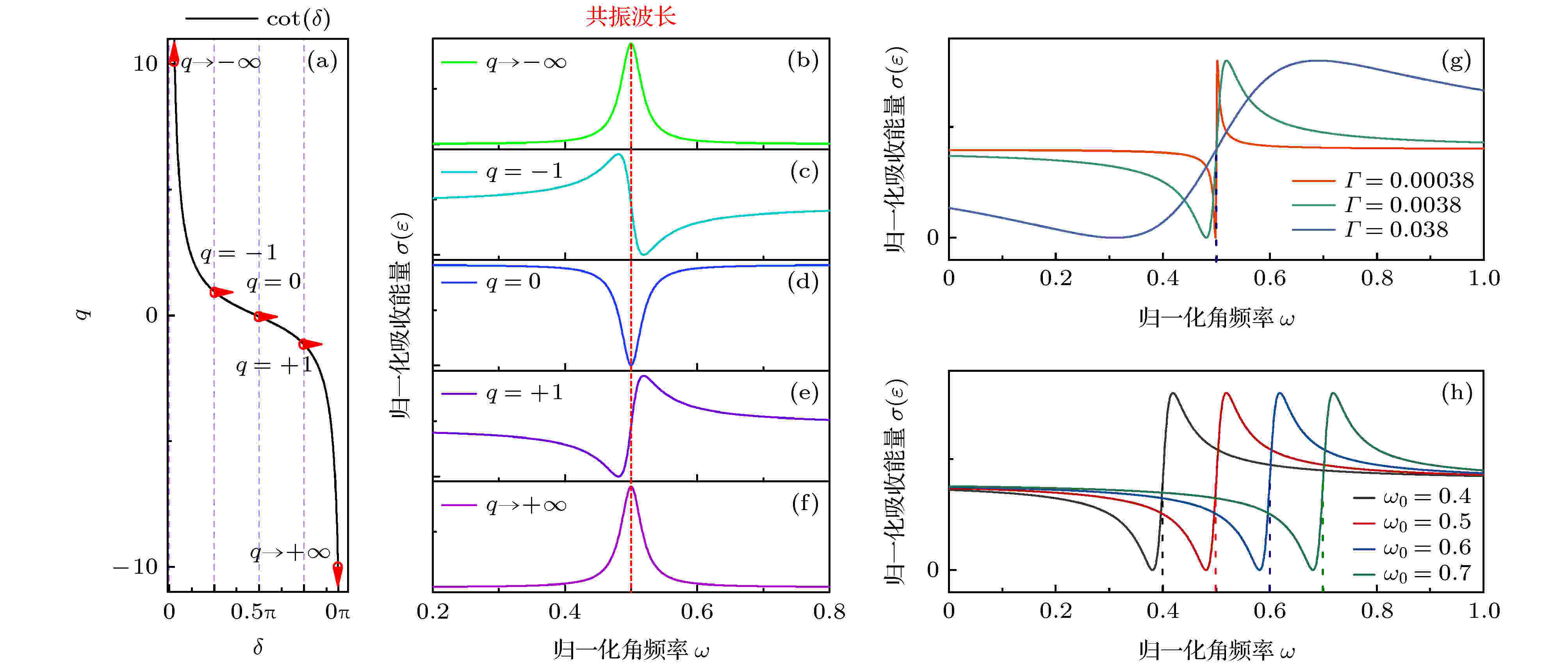
EDITOR'S SUGGESTION
2021, 70 (3): 034204.
doi: 10.7498/aps.70.20200550
Abstract +
The development of silicon photonics provides a method of implementing high reliability and high precision for new micro-nano optical functional devices and system-on-chips. The asymmetric Fano resonance phenomenon caused by the mutual coupling of optical resonant cavities is extensively studied. The spectrum of Fano resonance has an asymmetric and sharp slope near the resonance wavelength. The wavelength range for tuning the transmission from zero to one is much narrow in Fano lineshape, therefore improving the figure of merits of power consumption, sensing sensitivity, and extinction ratio. The mechanism can significantly improve silicon-based optical switches, detectors, sensors, and optical non-reciprocal all-optical signal processing. Therefore, the mechanism and method of generating the Fano resonance, the applications of silicon-based photonic technology, and the physical meaning of the Fano formula’s parameters are discussed in detail. It can be concluded that the primary condition for creating the Fano resonance is that the dual-cavity coupling is a weak coupling, and the detuning of resonance frequency of the two cavities partly determines Fano resonance lineshapes. Furthermore, the electromagnetically induced transparency is generated when the frequency detuning is zero. The methods of generating Fano resonance by using different types of devices in silicon photonics (besides the two-dimensional photonic crystals) and the corresponding evolutions of Fano resonance are introduced and categorized, including simple photonic crystal nanobeam, micro-ring resonator cavity without sacrificing the compact footprint, micro-ring resonator coupling with other structures (mainly double micro-ring resonators), adjustable Mach-Zehnder interferometer, and others such as slit waveguide and self-coupling waveguide. Then, we explain the all-optical signal processing based on the Fano resonance phenomenon, and also discuss the differences among the design concepts of Fano resonance in optimizing optical switches, modulators, optical sensing, and optical non-reciprocity. Finally, the future development direction is discussed from the perspective of improving Fano resonance parameters. The topology structure can improve the robustness of the Fano resonance spectrum; the bound states in continuous mode can increase the slope of Fano spectrum; the Fano resonance can expand the bandwidth of resonance spectrum by combining other material systems besides silicon photonics; the multi-mode Fano resonances can enhance the capability of the spectral multiplexing; the reverse design methods can improve the performance of the device. We believe that this review can provide an excellent reference for researchers who are studying the silicon photonic devices.
GENERAL

2021, 70 (3): 030301.
doi: 10.7498/aps.70.20200972
Abstract +
Quantum communication has the advantages of wide coverage and security, and is currently a hot research topic in the field of communication. In the process of free space quantum communication, quantum signals need transmitting at a certain height above the surface. Various environmental factors in free space, such as snowfall, sandstorms, rainfall, haze and floating dust, will inevitably affect quantum communication performance. However, so far, the influence of snowfall on the performance of quantum channels in free space near the surface has not been investigated. Thus, according to the intensity of snowfall, the snowfall is divided into four levels: light snow (${S_{\rm{1}}}$ ), medium snow (${S_{\rm{2}}}$ ), heavy snow (${S_{\rm{3}}}$ ) and blizzard (${S_{\rm{1}}}$ ). When the snow is falling in the air, it has an energy absorption effect on the light quantum signal, which is called the extinction effect. The different intensities of snow extinction have different effects on free space optical quantum signal. In this paper, first, a mathematical model for the extinction effects on optical quantum signal at different levels of snowfall is presented; then the quantitative relationship between snowfall and free space extinction attenuation, as well as the relationship between snowfall and channel limit survival function is established, channel capacities under different snowfall intensities, and quantum bit error rate are also given. Finally, the mathematical models of snowfall intensity, transmission distance and link attenuation, amplitude damping channel capacity, channel survival function and channel error rate are established. Simulation results show that when the snowfall intensity is 2.1 mm/d (${S_{\rm{1}}}$ ) and the transmission distance is 2.2 km, the communication link attenuation is 0.0362, the channel capacity is 0.7745, the channel survival function is 0.2329, and the channel error rate is 0.0105. When the snowfall intensity is 3.8 mm/d (${S_{\rm{2}}}$ ) and the transmission distance is 3.5 km, the communication link attenuation is 0.1326, the channel capacity is 0.4922, the channel survival function is 0.2099, and the channel error rate is 0.019. Thus, different snowfall intensity has different influence on the performance of free space quantum communication. Therefore, in practical applications, the communication parameters should be adjusted adaptively based on the snowfall intensity to improve the reliability of free space quantum communication.
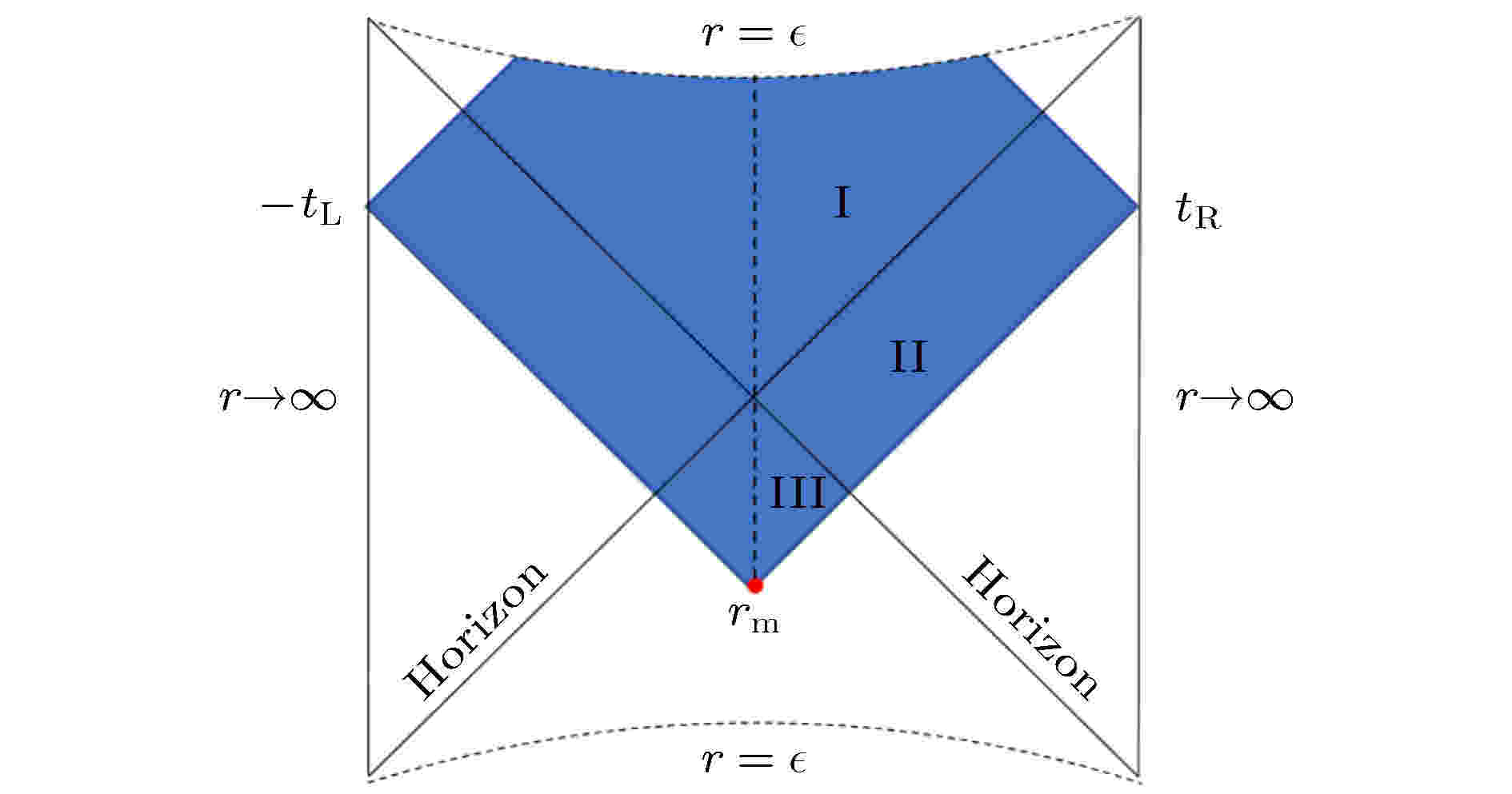
2021, 70 (3): 030401.
doi: 10.7498/aps.70.20201286
Abstract +
General Gauss-Bonnet gravity with a cosmological constant allows two anti-de Sitter (AdS) spacetimes to be taken as its vacuum solutions. It is found that there is a critical point in the parameter space where the two AdS vacuums coalesce into one, which is very different from the general Gauss-Bonnet gravity. Susskind’s team proposed a Complexity/Action duality based on AdS/CFT duality, which provides a new method of studying the complexity of black holes. Fan and Liang (Fan Z Y, Liang H Z 2019 Phys. Rev. D 100 086016) gave the formula of the evolution of complexity for general higher derivative gravity, and discussed the complexity evolution of the neutral planar Gauss-Bonnet-AdS black holes in detail by the numerical method. With the method of studying the complexity of general higher derivative gravity proposed by Fan and Liang (2019), we investigate the complexity evolution of critical neutral Gauss-Bonnet-AdS black holes, and compare these results with the results of the general neutral Gauss-Bonnet-AdS black holes, showing that the overall regularities of the evolution of the complexity of these two objects are consistent, and their main difference lies in the dimensionless critical time. As for the five-dimensional critical neutral Gauss-Bonnet-AdS black holes, when the event horizon of the black holes is flat or spherical, the dimensionless critical times of black holes with different sizes are identical, all reaching their minimum values. While in the higher dimensional cases, the differences in dimensionless critical time among spherically symmetric critical neutral Gauss-Bonnet-AdS black holes with different sizes are obviously less than those of general ones. These differences are probably related to the criticality of the neutral Gauss-Bonnet-AdS black holes.

EDITOR'S SUGGESTION
2021, 70 (3): 030601.
doi: 10.7498/aps.70.20201204
Abstract +
Transportable optical clocks have broad applications in scientific research and engineering. Accurate evaluation of systematic uncertainty for the transportable 87Sr optical lattice clock is a prerequisite for the practical realization of the optical clock. Four main frequency shifts of the 87Sr optical lattice clock are measured, i.e. blackbody-radiation (BBR) shift, collision shift, lattice alternating current (AC) Stark shift, and second-order Zeeman shift. Firstly, by measuring the temperature distribution on the surface of the magneto-optical trap cavity and analyzing the influence of different heat sources on atomic cloud, the BBR shift correction is measured to be 50.4 × 10–16 Hz with an uncertainty of 5.1 × 10–17. Secondly, the time-interleaved self-comparison method is used under high and low atom density condition to evaluate the collision shift of the system. The correction of collision shift is 4.7 × 10–16 with an uncertainty of 5.6 × 10–17. Thirdly, the lattice AC Stark shift is evaluated by the time-interleaved self-comparison method. By measuring the dependence of the lattice AC Stark shift on the wavelength of the lattice light, the magic wavelength is measured to be 368554393(78) MHz. As a result, the lattice AC Stark shift correction is 3.0 × 10–16 with an uncertainty of 2.2 × 10–16. Finally, using the time-interleaved self-comparison technology, the second-order Zeeman frequency shift is evaluated by measuring the fluctuation of the difference in center frequency between the ${m_{\text{F}}} = + {9 / 2} \to {m_{\text{F}}} = + {9 / 2}$ polarization spectrum and ${m_{\text{F}}} = - {9 / 2} \to {m_{\text{F}}} = - {9 / 2}$ polarization spectrum. The correction of second-order Zeeman shift is calculated to be 0.7 × 10–16, and corresponding uncertainty is 0.2 × 10–17. Experimental results indicate that the frequency shift correction due to the blackbody radiation is the largest, while the uncertainty caused by the lattice AC Stark effect is the largest in the evaluated shifts. The systematic shift is 58.8 × 10–16, the total uncertainty is 2.3 × 10–16. In the next work, the magneto-optical trap cavity will be placed in a blackbody-radiation cavity to reduce the blackbody-radiation shift. The uncertainty of the collision shift will be reduced by increasing the beam waist of the lattice and reducing the potential well depth of the lattice, which will reduce the density of atoms. What is more, the light source for the optical lattice after spectral filtering will be measured by an optical frequency comb locked to the hydrogen clock signal to reduce the uncertainty of the lattice AC Stark frequency shift. The systematic uncertainty is expected to be on the order of 10–17. The evaluation of the systematic uncertainty for the transportable 87Sr optical lattice clock lays the foundation for the practical application.

2021, 70 (3): 030701.
doi: 10.7498/aps.70.20201085
Abstract +
The hybrid composite materials are a new type of composite material. Due to their complex microscopic structures, it is very challenging to predict the equivalent thermal conductivities of hybrid composites. In this paper, an innovative hybrid wavelet-based learning method assisted multiscale analysis is developed to predict the effective thermal conductivities of hybrid composite materials with heterogeneous conductivity by the asymptotic homogenization method, wavelet transform method, and machine learning method. This innovative approach mainly includes two parts: off-line multi-scale modeling and on-line machine learning. Firstly, the material database about thermal transfer performance of hybrid composites is established by the asymptotic homogenization method and off-line multi-scale modeling, and then the off-line material database is preprocessed by the wavelet transform method. Secondly, the artificial neural network and support vector regression method are employed to establish the on-line machine learning model for predicting the equivalent heat conduction properties of hybrid composites. Finally, the effectiveness of the proposed hybrid wavelet-based learning method is verified by numerical experiments on the periodic and random hybrid composites. The numerical results show that the hybrid wavelet-based artificial neural network method owns the optimal capability of parameter prediction and anti-noise. Furthermore, it should be emphasized that the hybrid wavelet-based learning method can not only extract the important features of off-line material database for random hybrid composites with high-dimensional large-scale data features, but also significantly reduce the quantity of input data for ensuring the successful on-line supervised learning and improve the training efficiency and anti-noise performance of the machine learning model. The established hybrid wavelet-based learning method in this paper can not only be used to evaluate the equivalent thermal conductivities of hybrid composite materials, but also further extend to the predicting of the equivalent physical and mechanical properties of composite materials.
ATOMIC AND MOLECULAR PHYSICS
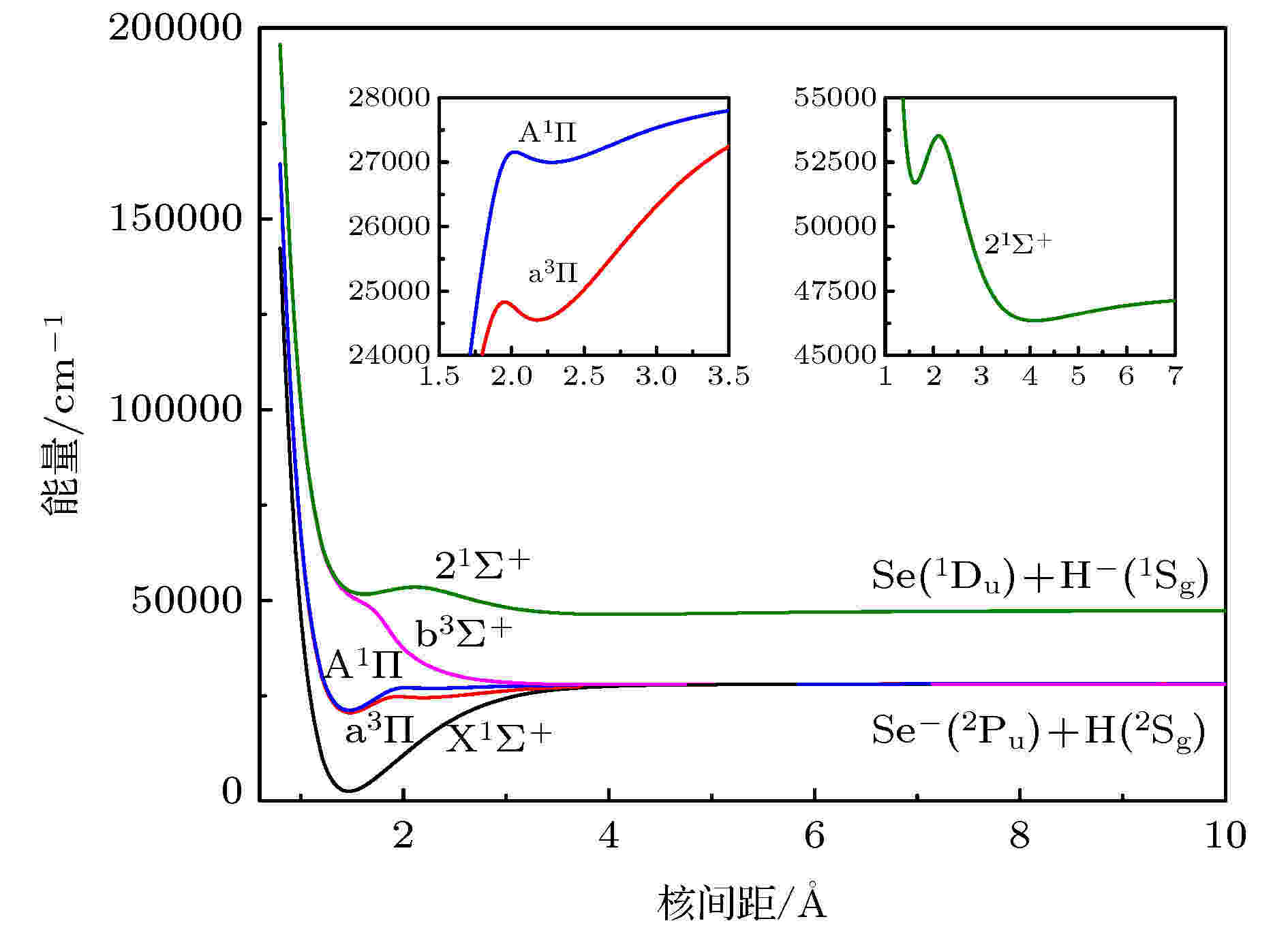
2021, 70 (3): 033101.
doi: 10.7498/aps.70.20201413
Abstract +

2021, 70 (3): 033102.
doi: 10.7498/aps.70.20201364
Abstract +
The point defect of two-dimensional hexagonal boron nitride (hBN) has recently been discovered to achieve single photon emission at room temperature, and it has become a research hotspot. Despite its important fundamental and applied research significance, the origin of the atomic structure of luminescence defects in hBN is still controversial. In this paper, first-principle calculations based on density functional theory are used to study a defect (CN)3VB in the hexagonal boron nitride monolayer (hBN) where three N atoms near the B vacancy are replaced by C atoms. At the B vacancy of hBN, the three N atoms each carry an in-plane dangling bond and the corresponding unpaired electron, and the unpaired electron can be eliminated by C substitution. We systematically study the geometric structure, electronic structure and optical properties of (CN)3VB defects, analyze the thermodynamic stability of defects through the calculation of the atomic structure, formation energy, and charge state of the defect, and analyze the position in the band gap and its atomic orbital contribution of defect state through energy band structure and wave function. We also analyze its optical properties through dielectric function and absorption coefficient, and predict its luminous photon energy. The results show that the defect can change from a symmetric metastable state to an asymmetric ground state structure with three C atoms connected together through atomic structure relaxation. The formation energy of asymmetric (CN)3VB is 7.94 eV, which is 3.72 eV lower than that of symmetric one. The formation of defects introduces some local defect states contributed by defect dangling σ bonds and reconstructed π bonds in hBN. The defects have valence states between –2 and +2, and the thermodynamic transition energy level of asymmetric (CN)3VB is higher than that of symmetric (CN)3VB. In the transition from the metastable state to the ground state, these defect states can redshift the light absorption boundary of hBN, enhance the absorption intensity of visible light by hBN, and cause internal optical transitions. Among them, there is a visible light transition with an energy threshold around 2.58 eV in the asymmetry (CN)3VB defect. Single boron atom vacancy defect and (CN)3VB have optical transitions near infrared and ultraviolet energy, respectively. The present work will help to further understand the composition and optical properties of point defects in hBN, and provide a theoretical basis for experimentally exploring the origin and properties of the atomic structure of light-emitting point defects.
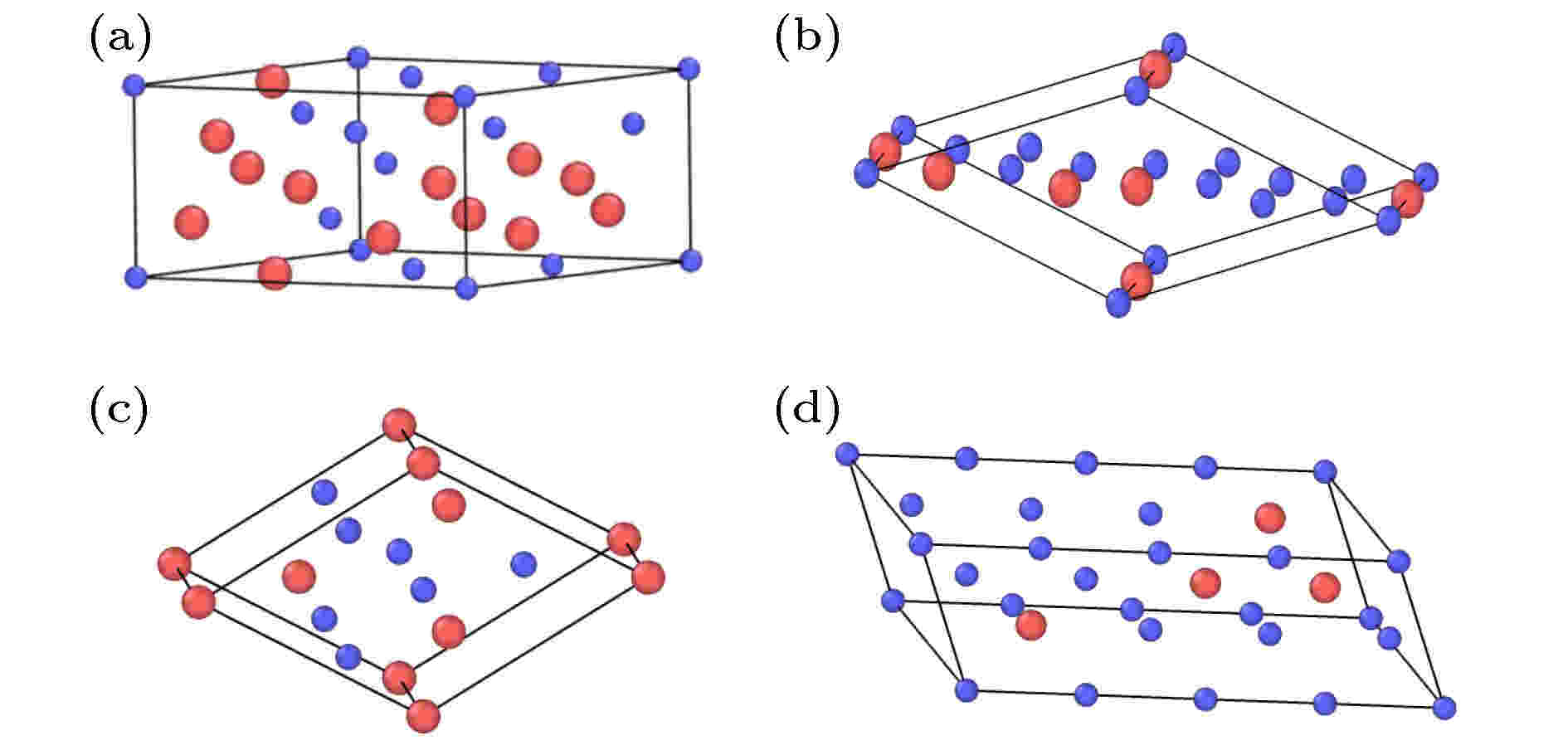
EDITOR'S SUGGESTION
2021, 70 (3): 033103.
doi: 10.7498/aps.70.20201407
Abstract +
Irradiation damage to zirconium alloys (e.g., zirconium niobium (Zr-Nb) alloy) is the key to the design of fission-reactor structural materials and fuel rod cladding materials. Atomic scale computational simulations such as molecular dynamics and first principles are often needed to understand the physical mechanism of irradiation damage. For the simulation of randomly substitutional solid solution, it is necessary to construct large-sized supercells that can reflect the random distribution characteristics of alloy elements. However, it is not suitable to use large-size supercells (such as ≥ 200 atoms) for first principle calculation, due to the large computational cost. Special quasirandom supercells (SQS) are usually used for first principles calculation. The SQS can partly reflect the random distribution characteristics of alloy elements, but it only corresponds to one configuration for specific components, hence whether this model can reflect the statistical average of multiple local configurations in a real randomly substitutional solid solution is still an open question, and needs further studying and verifying. Molecular dynamics (MD) simulation can be carried out on the randomly substitutional solid solution with a larger scale based on random substitution (RSS) method, these supercells include more local configurations. Therefore, the MD studies of Zr-Nb alloy are carried out for the RSS and SQS-extended supercells. The critical size of RSS supercell which can truly reflect the statistical properties of solid solution alloy is determined. Then the lattice constant, formation energy and energy-volume relationship of SQS-extended supercell of Zr-Nb alloy and a series of RSS supercells are calculated and compared. The results show that the lattice constants, the formation energy and energy volume curves of the solid solution obtained by SQS supercell simulation are close to a series of corresponding statistical values of the physical properties of RSS supercells, so the SQS supercells can be used to study the random substitution of solid solution alloys.
ELECTROMAGNETISM, OPTICS, ACOUSTICS, HEAT TRANSFER, CLASSICAL MECHANICS, AND FLUID DYNAMICS
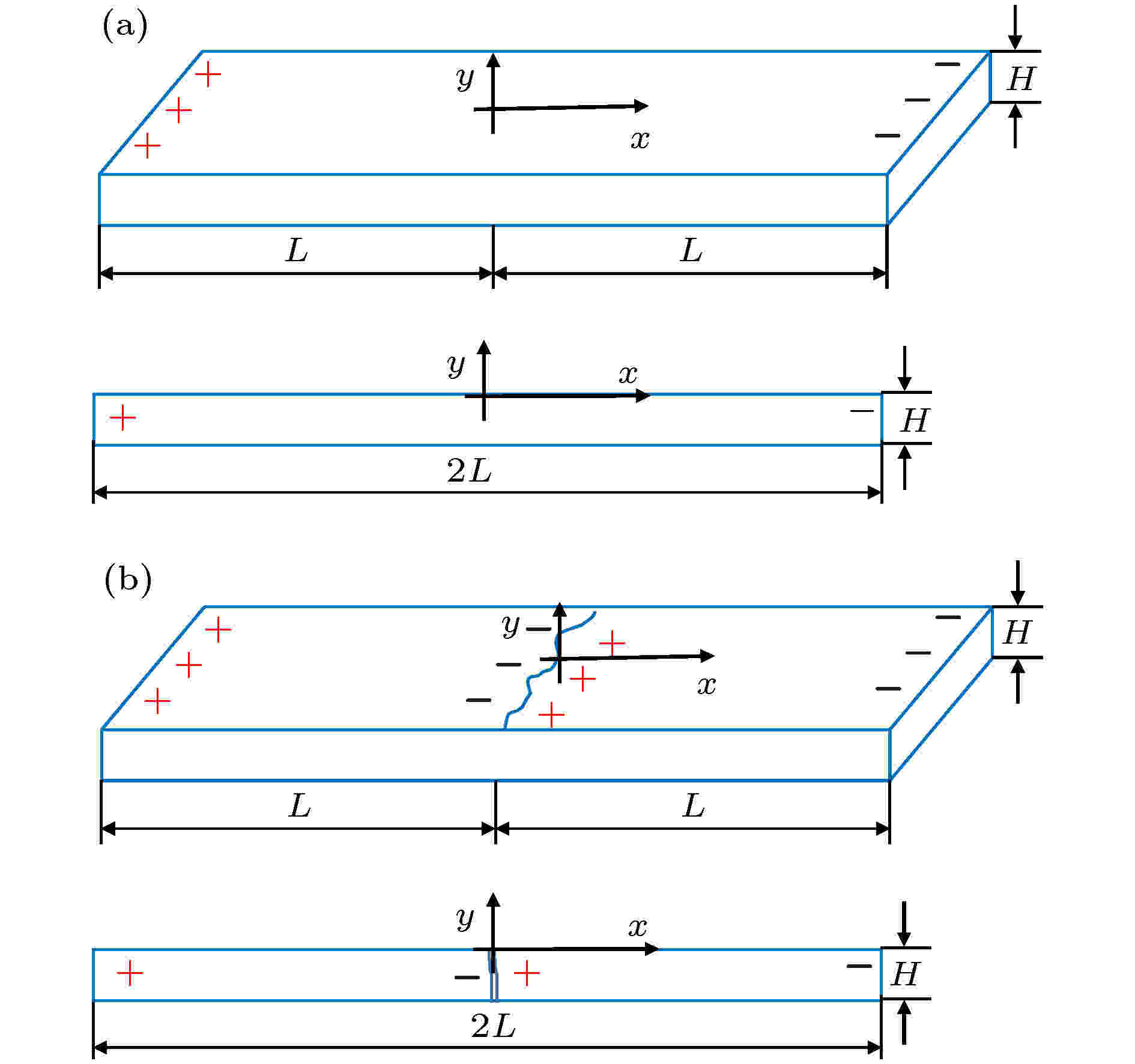
2021, 70 (3): 034101.
doi: 10.7498/aps.70.20200937
Abstract +
Magnetic dipole theory has been widely and successfully used to explain the leakage magnetic field signals. Because the model parameter such as magnetic dipole density is not easy to quantify, magnetic dipole theory often needs normalizing in application, which is considered to be unsuitable for quantitatively analyzing the magnetic memory signals with the stress effect. In this paper, the theoretical model of magneto-mechanical coupling magnetic dipole is established, which is suitable for analyzing the stress effect on magnetic signals in magnetic memory testing method. Based on the ferromagnetic theory, the equivalent field under the combined action of the applied load and the magnetic field is determined. And then, the magneto-mechanical analytical model is obtained for the isotropic ferromagnetic material under the weak magnetic field based on the first-order magnetization approximation in the weak magnetization state. Under the assumptions of rectangular and V-shaped magnetic charge distribution for the two-dimensional magnetic signal problem, the theoretical analytical models of the magnetic memory signals from the smooth and cracked specimens, and the analytical models of the magnetic memory signal induced by the rectangular and V-shaped surface defect are established. Based on the analytical solution of the proposed magneto-mechanical magnetic dipole theory, the difference in signal between before and after the failure of the specimen, the signal from the rectangular and V-shaped defect, and other influencing factors and laws of the magnetic signal are analyzed in detail. In particular, the influence of stress, environmental magnetic field, defect morphology and size, lift-off effect, specimen size and other factors on magnetic memory signals can be described based on the analytical solution of magneto-mechanical magnetic dipole models proposed in this paper. The proposed analytical model of magneto-mechanical magnetic dipole in this paper is simple and easy to use, and the present research shows that the proposed analytical solution in this paper can explain some basic experimental phenomena and laws in magnetic memory testing experiments. In addition, the precise magneto-mechanical coupling quantitative model combined with the finite element analysis method is still needed for accurately analyzing the magnetic memory signals in experiment.

2021, 70 (3): 034102.
doi: 10.7498/aps.70.20201034
Abstract +
Electromagnetic diffusion surface can reduce the radar cross section, thus profiting stealth of targets. Terahertz diffusion surface has a wide prospect in the field of next-generation radar and communication, promising to act as a kind of intelligent smart skin. In this paper, utilizing the excellent tunable properties of graphene in the terahertz band, a hybrid structure of graphene and metal which has inverse phase response of reflecting waves is proposed. The reflection phase switches in the mechanism of resonant modes and can be controlled efficiently by the bias voltage. Meanwhile, unlike metal materials, graphene has a non-negligible loss characteristic, which leads the response amplitudes corresponding to the two different switching states to be inconsistent with each other. According to the interference and superposition principle of electromagnetic field, it is not conducive to eliminating the coherent far-field, leading to an unsatisfactory diffusion result. In this paper, we present a “molecular” structure by secondary combination of the above-mentioned reverse phase element states, and take it as the basic element of the diffusion surface. Finally, we use particle swarm optimization to optimize the arrangement of “molecular” structures. The final diffusion surface consists of a combinatorial design of “molecules” rather than randomly distributed reflection units. In addition, molecules designed artificially have similar amplitude responses but different phase responses, which improves the convergence speed and reduces the computation quantity during algorithm evolution. The method of designing molecular structure, described in this paper, is simple, rapid and widely applicable, which effectively improves the amplitude-to-phase modulation ability of graphene metasurface against electromagnetic waves. When diffuse reflection optimization is applied to most of graphene metasurfaces, the method described in this paper can achieve the results that are the same as or even better than the results after a large number of iterations of traditional particle swarm optimization in the most computation-efficient manner. The results show that the dynamic diffusion surface designed by this method has the advantages of fast convergence speed and small far-field peak.

2021, 70 (3): 034201.
doi: 10.7498/aps.70.20201121
Abstract +
Transmission of the subwavelength metal aperture excited by the surface plasmon resonance is much higher than that from the Bethe theory. However, due to the sensitivity of resonant frequency and the loss of metal in optical band, it is difficult to achieve broadband and high transmission of the subwavelength metal aperture through surface plasmon resonance. In this article, the broadband and high transmission of the subwavelength metal aperture is realized when Mie-resonant-coupled silicon nanoparticles placed on both sides of the metal aperture are used to replace the surface plasmon resonance. The full wave simulation results show that bandwidth of the transmission coefficient more than 90% of the subwavelength aperture ($ {r \mathord{\left/ {\vphantom {r {\lambda = 0.1}}} \right. } {\lambda = 0.1}}$ ) reaches 65 nm by using Mie-resonance-coupled silicon nanoparticles. Compared with the transmission induced by surface plasmon resonance, the peak value is improved by 1.5 times and the 3 dB bandwidth is widened by 17 times. According to the coupled mode theory, the equivalent circuit model of transmission of the subwavelength metal aperture added with Mie-resonance-coupled silicon nanoparticles is established, and the element parameters in the circuit model are inversed under the critical coupling state. Further research shows that transmission rule of the subwavelength metal aperture added with Mie-resonance coupled silicon nanoparticles can be accurately revealed by changing the coupling coefficient in the equivalent circuit model, and the results are consistent with the full wave electromagnetic simulation results. The mathematical expression of the interaction between light and Mie-resonance-coupled subwavelength metal aperture is found, therefore it can inspire us to construct certain functional modules in optical field according to circuit design method.
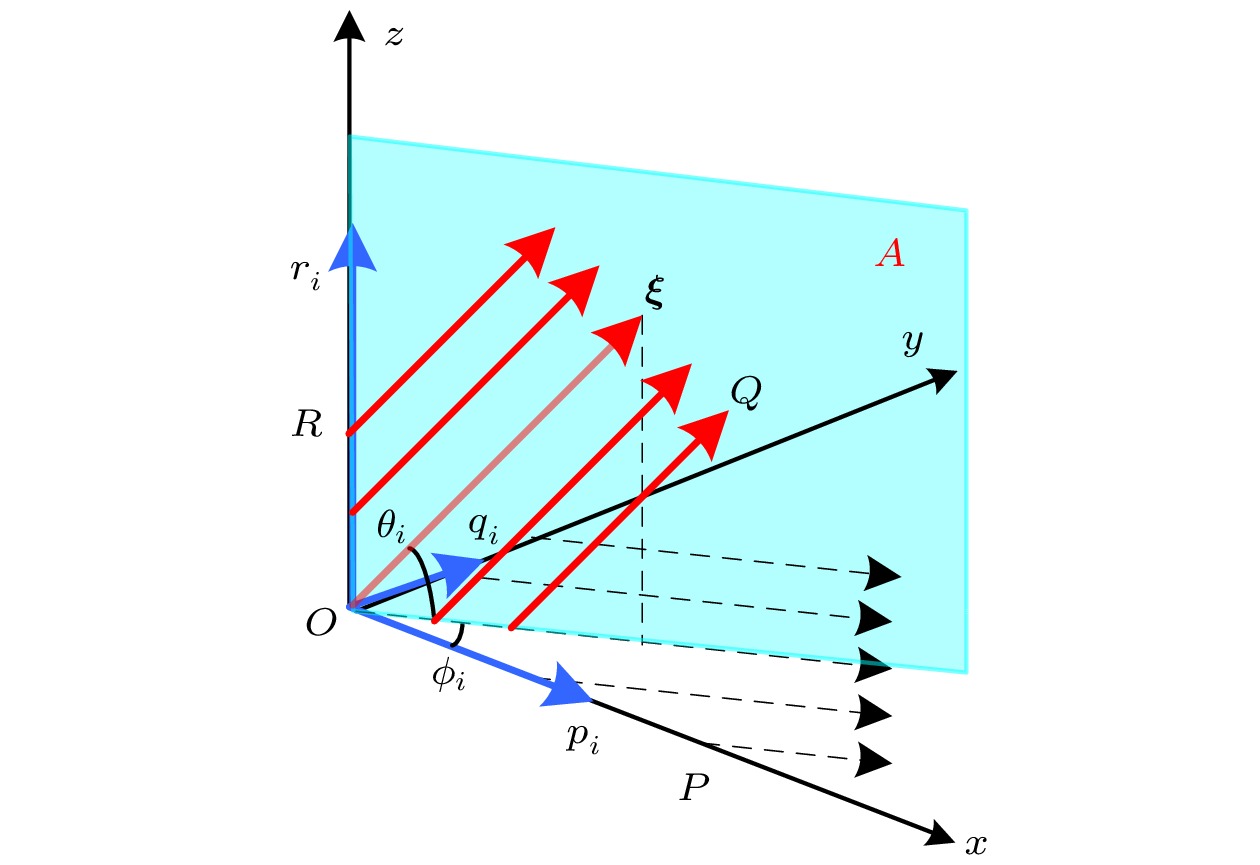
2021, 70 (3): 034202.
doi: 10.7498/aps.70.20200927
Abstract +

2021, 70 (3): 034203.
doi: 10.7498/aps.70.20201042
Abstract +
In order to deal with the thermal management problem of high-energy high-repetition rate laser amplifiers, the efficient heat removal in water-cooled Nd:YAG active mirror amplifiers is investigated in detail through numerical modeling and experimental analysis. According to the low Reynolds number k-ε turbulence model, a full fluid-solid conjugate heat transfer model is established to give a comprehensive model of flow and thermal characteristics in three dimensions. The thermal distributions obtained from the model are then used to calculate all mechanical stresses in the laser medium and thermally-induced wavefront distortions. In comparison with the standard k-ε turbulence model, the influences of the near-wall treatments of the above model on the process of fluid flow, convection diffusion and heat conduction, and temperature distributions are analyzed. Meanwhile, the effects of coolant flow rate and pump parameter on the flow field characteristics, temperature and wavefront distributions of the YAG disk are also studied. Numerical simulation results reveal that the temperature distribution of the laser medium is closely related to the viscous effect in the solid-liquid boundary layer. Although the heat deposition distribution of the laser medium is symmetrical, the temperature profile is asymmetrical as a result of the increasing water temperature along the water flow. The maximum temperature rise of the disk is at the outlet end, and the position remains almost unchanged. The front-surface temperature distributions and wavefront profiles of Nd:YAG vary nonlinearly with the coolant flow rates, but linearly with the pump parameter. Model predictions show that when the laser amplifier operates at a repetition rate of 50 Hz, the thermal diffusion of the coolant mainly occurs in a range of 100 μm, and the maximum temperature difference of the coolant reaches up to 10.85 ℃. Correspondingly, the maximum temperature variation over the front-surface active region is less than 4 ℃, with an average temperature of 49.62 ℃, which leads to a total peak-to-valley wave front distortion of 7.27λ. The experimentally measured temperature distributions are in reasonable agreement with numerical simulations. The research results are beneficial to designing and optimizing the high-energy, high-repetition rate water-cooled Nd:YAG active mirror amplifiers.

2021, 70 (3): 034205.
doi: 10.7498/aps.70.20201135
Abstract +
The laser frequency scanning interferometry, as a non-contact method, has non-ranging blind zone and achieves multi-target testing in a single measurement. The beat frequency of target can be extracted by Fourier transform, and then the distance can be solved. However, due to the limitation of laser frequency modulation bandwidth, the resolution of target obtained by Fourier transform is limited to the inherent resolution. In order to solve this problem, in this paper we propose to use the estimating signal parameter via rotational invariance technique (ESPRIT) to perform spectrum analysis on the measured signal. In the experiment, the resampling method is adopted to correct the non-linearity of the measured signal beat frequency, and then the ESPRIT algorithm is used to obtain the target distance. The results show that the Fourier transform algorithm cannot distinguish the target signal from the frequencies of adjacent target, but the ESPRIT algorithm can do. The thickness of the measured target is 2.08 mm. This provides ideas for measuring, such as damage point in the proximity of the fiber, height of thin step, or small hole.
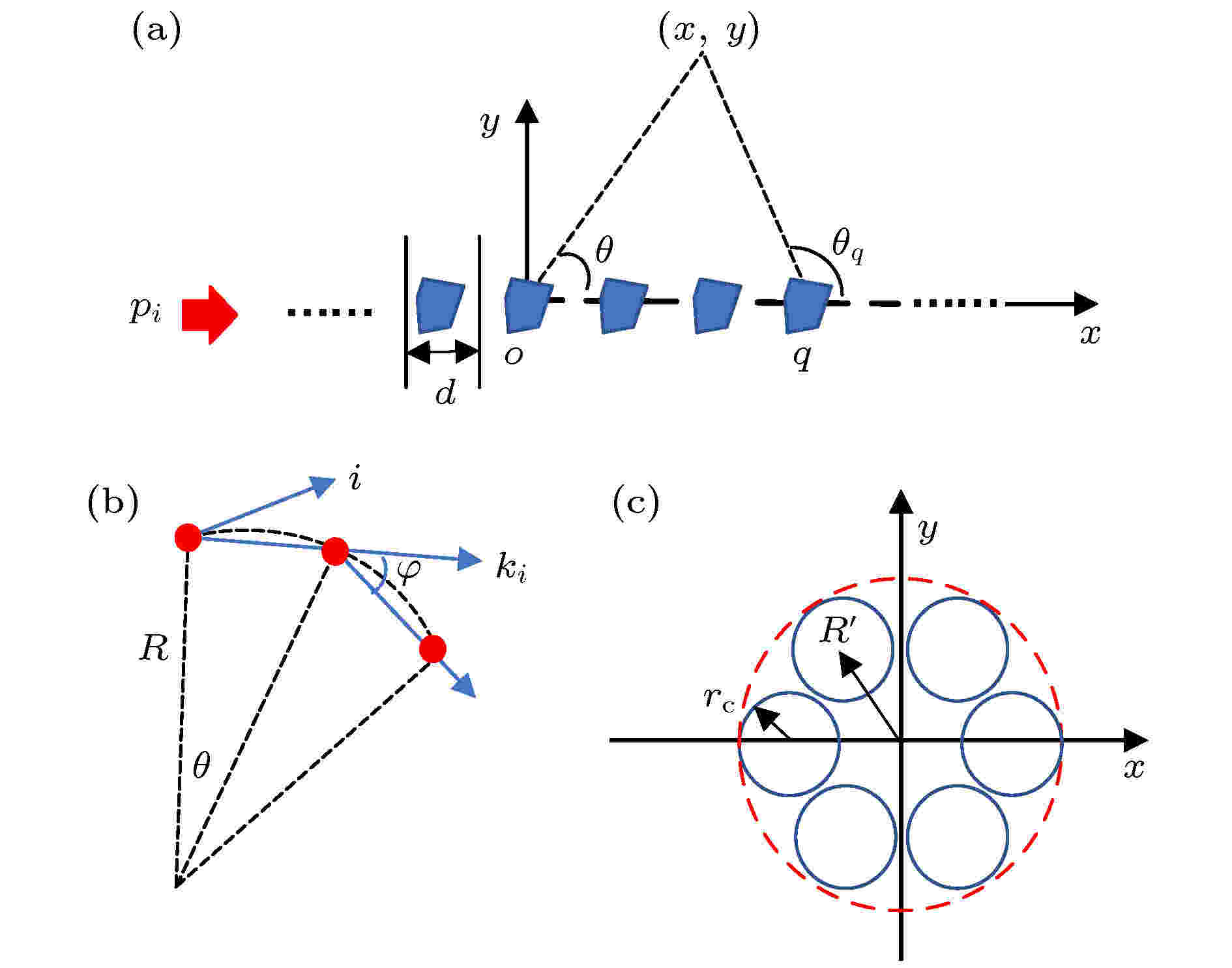
2021, 70 (3): 034301.
doi: 10.7498/aps.70.20201270
Abstract +
A monolayer bend waveguide is designed based on the features of Rayleigh-Bloch (RB) mode wave in one-dimensional diffraction grating. The feasibility that the RB mode wave can transmit along the bend waveguide is demonstrated by the time-domain and frequency-domain finite element method, respectively. The results show that two different modes of transmission wave exist because of employing the circled unit cells. They possess different acoustical energy localization positions. In mode-1, the energy is localized between unit cells. In mode-2, the energy is localized in the center of unit cell, therefore, acoustic wave transmits with nearly no loss. Modulated sinusoidal wave and Gaussian pulse wave are used in the time-domain investigation. Because only RB mode waves can transmit and different modes have different energy distributions, the bend waveguide acts as an acoustic filter for the broadband waves. This study is conducive to the acoustic wave directional transmission, acoustic signal detection and identification.

2021, 70 (3): 034302.
doi: 10.7498/aps.70.20201233
Abstract +
The rough sea bottom has a large effect on underwater acoustic propagation and underwater acoustic detection applications. By using the typical shallow water environment from the Yellow Sea, the acoustic propagation characteristics under the condition of both periodic rough sea bottom and strong negative thermocline layer are systematically analyzed by using the parabolic equation model RAM (where RAM stands for range-dependent acoustic model) and ray theory. For a low-frequency and short-range acoustic source, the transmission loss (TL) increases up to about 5–30 dB due to the existence of the periodic rough bottom. Abnormal TLs and pulse arrival structures with different source depths, different periods and heights of the rough bottom are analyzed and summarized. Specifically, when the period of the rough bottom is constant, TL increases with the height of the rough bottom increasing. When the height of the rough bottom is constant, the effect of the rough bottom on the sound propagation becomes smaller with the increase of the period. The mechanism of the TL difference caused by rough bottom is explained by using the ray theory. The incidence and reflection angle of the sound ray on the sea bottom are changed due to the periodic rough bottom, which makes small grazing angles of some of the rays incident at sea bottom become large grazing angles, and the bottom loss increases. On the other hand, the change of the reflection angle increases the number of ray interaction with the sea bottom, causing the reversion propagation. Therefore, the energy of the sound field will attenuate with range increasing. The influence of the periodic rough bottom on the sound pulse propagation is mainly reflected in the energy conversion between sound rays (or normal modes) with different angles, the increasing of energy attenuation of some sound rays with large angles, and the decreasing of multipath structure. The change of the arrival time and relative amplitude of the multipath structure affect the frequency spectrum of the sound field, which will affect the performance of the method based on matching field localization. Most of existing studies focus on the influence of the change in large scale sea bottom topography on the sound field, but there are few studies on small scale periodic sea bottom fluctuations, and the relevant summary of the law of sound propagation is lacking. When sonar is used in the actual shallow water environment, more attention should be paid to the influence of the periodic rough bottom. In addition, the present research results also have important reference significance for the spatial accuracy of surveying and mapping of sea bottom topography.

2021, 70 (3): 034401.
doi: 10.7498/aps.70.20201005
Abstract +
Supercritical CO2 can be used as a heat transfer fluid in a solar receiver, especially for a concentrating solar thermal power tower system. Such applications require better understanding of the heat transfer characteristics of supercritical CO2 in the solar receiver tube in a high temperature region. However, most of the existing experimental and numerical studies of the heat transfer characteristics of supercritical CO2 in tubes near the critical temperature region, and the corresponding heat transfer characteristics in the high temperature region are conducted. In this paper, a three-dimensional steady-state numerical simulation with the standard k-ε turbulent model is established by using ANSYS FLUENT for the flow and heat transfer of supercritical CO2 in a heated circular tube with an inner diameter of 6 mm and a length of 500 mm in the high temperature region. The effects of the fluid temperature (823–1023 K), the flow direction (horizontal, downward and upward), the pressure (7.5–9 MPa), the mass flux (200–500 kg·m–2·s–1) and the heat flux (100–800 kW·m–2) on the convection heat transfer coefficient and Nusselt number are discussed. The results show that the convection heat transfer coefficient increases while Nusselt number decreases nearly linearly with fluid temperature increasing. Both fluid direction and pressure have negligible effects on the convection heat transfer coefficient and Nusselt number. Moreover, the convective heat transfer coefficient and Nusselt number are enhanced greatly with the increasing of mass flux and the decreasing of heat flux, which is more obvious at a higher heat flux. The influences of buoyancy and flow acceleration on the heat transfer characteristics are also investigated. The buoyancy effect can be ignored within the present parameter range. However, the flow acceleration induced by the high heat flux significantly deteriorates the heat transfer preformation. Moreover, eight heat transfer correlations of supercritical fluid in tubes are evaluated and compared with the present numerical data. The comparison indicates that the correlations based on the thermal property modification show better performance in the heat transfer prediction in the high temperature region than those based on the dimensionless number modification. And Nusselt number predicted by the best correlation has a mean absolute relative deviation of 8.1% compared with the present numerical results, with all predicted data points located in the deviation bandwidth of ±20%. The present work can provide a theoretical guidance for the optimal design and safe operation of concentrating solar receivers where supercritical CO2 is used as a heat transfer fluid.
PHYSICS OF GASES, PLASMAS, AND ELECTRIC DISCHARGES
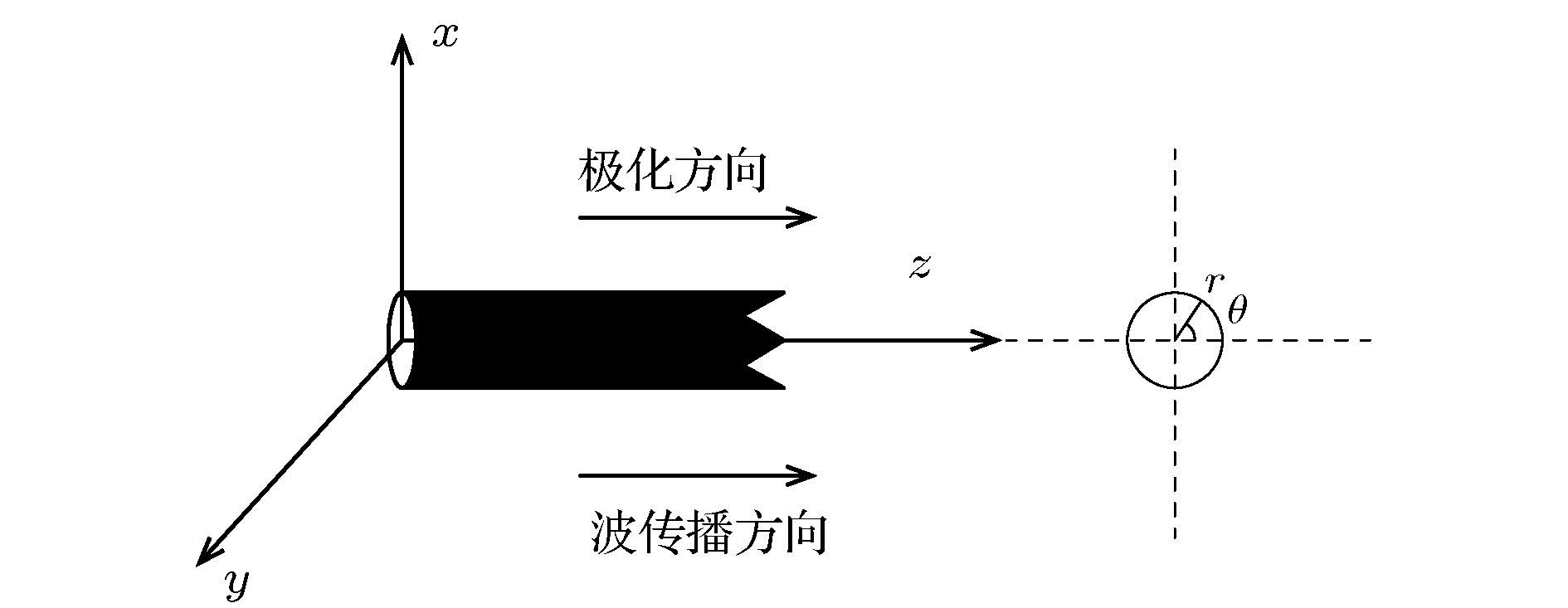
Longitudinal wave analysis of infinite length piezoelectric circular rod based on temperature effect
2021, 70 (3): 035201.
doi: 10.7498/aps.70.20200774
Abstract +
Piezoelectric elements have been commonly used because of their wide applications in sensors, transducers, and some micro intelligent structures. However, in the fields of aviation, aerospace, and automation, some relevant equipment works in a harsh environment and is susceptible to the temperature change, thereby leading its performances to be greatly affected. Therefore, the problem of nonlinear wave relating to piezoelectric circular rods in different temperature fields is studied by modeling and numerical analysis. Firstly, based on the theory of finite deformation, we take infinite piezoelectric circular rod as a research object and consider the effects of transverse inertia and equivalent Poisson's ratio under the thermoelectric coupling action. Using the Hamilton principle and introducing the Euler equation, the longitudinal wave equation of piezoelectric circular rod is obtained. Secondly, Jacobi elliptic cosine function and Jacobi elliptic sine function expansion method are used to solve the wave equation of the piezoelectric circular rod, and the solitary wave solution and the exact periodic solution of the wave equation are obtained. It is found that the periodic solution can be reduced into a solitary wave solution under certain conditions, and it is proved theoretically that there may be solitary wave stably propagating in a piezoelectric circular rod. Finally, the dispersion curves of different wave velocity ratios and the curves about influences of temperature field on the waveform, amplitude and wave number of the piezoelectric rod are obtained by Matlab. The numerical results show that the wave velocity decreases with the increase of temperature when the wave velocity ratio is constant. Given the temperature is constant, it can be found that with the increase of the ratio, the amplitude of solitary wave gradually increases while the wavelength gradually decreases. In addition, the images obtained show that although temperature change can cause the characteristics of solitary waves to change, the solitary waves are always symmetrical bell shaped waves in the propagation process, reflecting the stability characteristics under the combined action of nonlinear and dispersion effects. Therefore, the variation of temperature field can influence and control some propagation characteristics of solitary waves. Moreover, the wave theory has been widely used in the nondestructive testing of structures and the improving of information transmission quality due to its special stability.
CONDENSED MATTER: STRUCTURAL, MECHANICAL, AND THERMAL PROPERTIES

2021, 70 (3): 036101.
doi: 10.7498/aps.70.20201288
Abstract +
Nanocrystalline rare earth hexaborides Nd1–xEuxB6 powders are successfully synthesized by the simple solid-state reaction in vacuum condition for the first time. The effect of Eu doping on the crystal structure, grain morphology, microstructure and optical absorption properties of nanocrystalline NdB6 are investigated by X-ray diffraction, scanning electron microscope (SEM), high resolution transmission electron microscopy (HRTEM) and optical absorption measurements. The results show that all the synthesized samples have a single-phase CsCl-type cubic structure with space group of Pm-3m. The SEM results show that the average grain size of the synthesized Nd1–xEuxB6 powders is 50 nm. The HRTEM results show that nanocrystalline Nd1–xEuxB6 has good crystallinity. The results of optical absorption show that the absorption valley of nanocrystalline Nd1–xEuxB6 is redshifted from 629 nm to higher than 1000 nm with the increase of Eu doping, indicating that the transparency of NdB6 is tunable. Additionally, the X-ray absorption near-edge structure spectra μ(E) around the Nd and Eu L3 edges for nanocrystalline NdB6 and EuB6 show that total valence of Nd ion is estimated at +3 in nanocrystalline NdB6 and total valence of Eu ion in nanocrystalline EuB6 is +2. Therefore, the Eu-doping into NdB6 effectively reduces the electron conduction number and it leads the plasma resonance frequency energy to decrease. In order to further qualitatively explain the influence of Eu doping on the optical absorption mechanism, the first principle calculations are used to calculate the band structure, density of states, dielectric function and plasma resonance frequency energy. The calculation results show that the electron band of NdB6 and EuB6 cross the Fermi energy, indicating that they are typical conductors. In addition, the plasmon resonance frequency can be described in the electron energy loss function. The plasmon resonance frequency energy of NdB6 and EuB6 are 1.98 and 1.04 eV, which are corresponding to the absorption valley of 626.26 and 1192.31 nm, respectively. This confirms that the first principle calculation results are in good consistence with the experimental optical absorption valley. Therefore, as an efficient optical absorption material, nanocrystalline Nd1–xEuxB6 powders can expand the optical application scope of rare earth hexaborides.

2021, 70 (3): 036301.
doi: 10.7498/aps.70.20201387
Abstract +
Formamdinium lead triiodide (FAPbI3) perovskite has developed as a promising candidate in solar cells for its excellent optoelectronic property. However, the poor environmental stability is still a critical hurdle for its further commercial application. Element doping is an effective method of improving the stability of FAPbI3 materials. It has been reported that the FA1–xCsxPbI3–yBry stability for heat and water resistance were greatly improved by Cs cations and Br anions co-doping. In this study, we perform first-principles calculations to systematically investigate the crystal structures, electronic structures, and optical properties of FA1–xCsxPbI3–yBry. We obtain several stable crystal structures of FA1–xCsxPbI3–yBry (x = 0.125, y = 0—0.6) in the cubic phase for different ratios of Cs cations to Br anions. By analyzing the structures of these mixed ion perovskites, it is revealed that the lattice parameters decrease linearly with the increase of concentration of Cs cations and Br anions, which is consistent with previous experimental result. In this work, the formation energy difference (∆E) is calculated and our results show that the mixing of Cs cations and Br anions could increase the thermodynamic stability compared with pure FAPbI3. The FA0.875Cs0.125PbI2.96Br0.04 is found to be the most stable in all composites investigated. Furthermore, the band gap, hole and electron effective mass increase with increasing proportion of Br anions, indicating an effective strategy for extending the absorption range of FAPbI3 perovskites into the ultraviolet of the solar spectrum, thereby affecting the carrier transport mechanism in this material. Density of states (DOS) analysis indicates that the DOS of valence band edge increases with increasing proportion of Br anions and enhancing transitions between the valence and conduction bands. Finally, the absorption rate, carrier collection efficiency, external quantum efficiency, short-circuit current density, open circuit voltage and volt-ampere characteristics for the planar structure perovskite solar cell are analyzed by the equivalent optical admittance method. For the FA1–xCsxPbI3–yBry (x = 0.125, y = 0.04, thickness = 0.5—1.0 μm) solar cell, the short-circuit current density and the open circuit voltage are estimated at about 24.7 mA·cm–2 and 1.06 V. It is demonstrated that the co-doping Cs cations and Br anions can improve the stability of the system without reducing short-circuit current density, which may provide some theoretical guidance in preparing the perovskite solar cells with high efficiency and excellent stability.
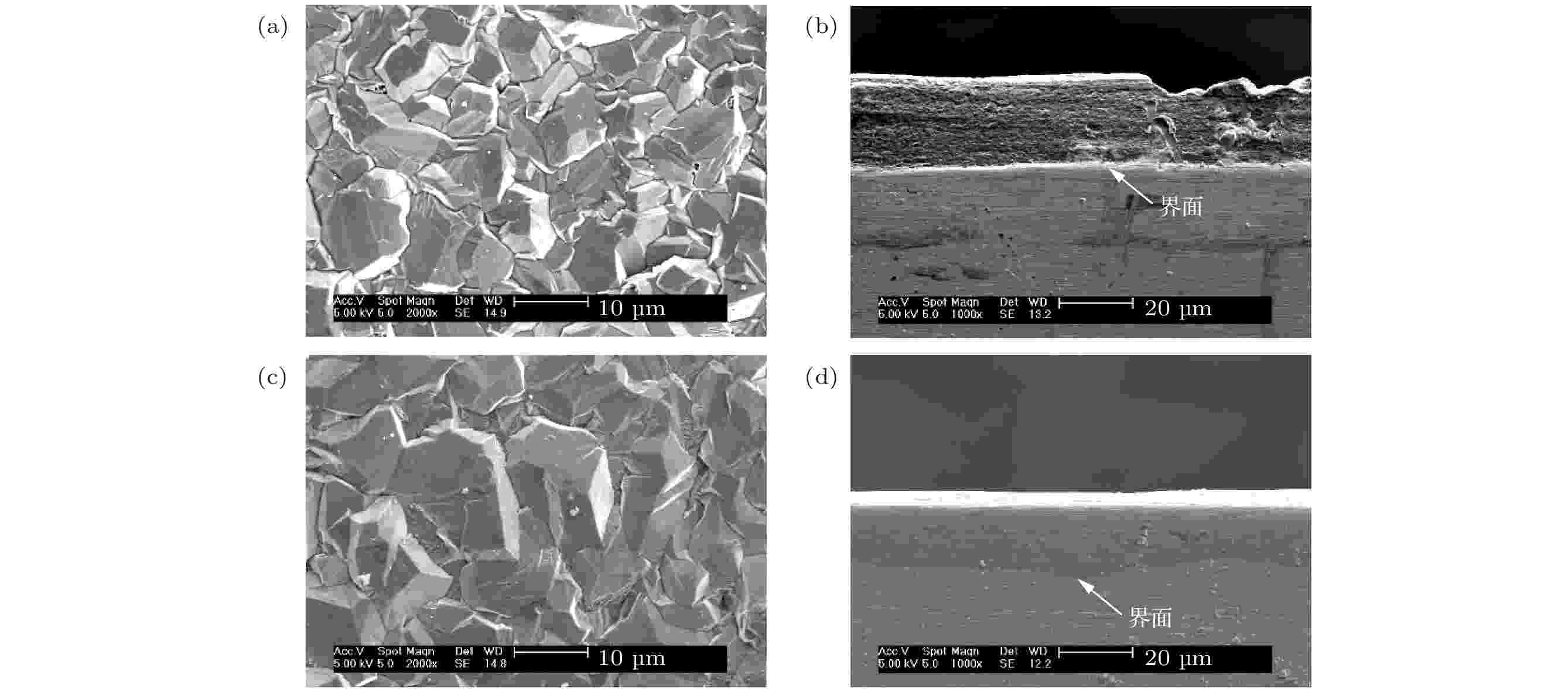
2021, 70 (3): 036801.
doi: 10.7498/aps.70.20200762
Abstract +
Reduced activation ferritic/martensitic steel is one of the candidate materials for tritium breeding module in the fusion reactor. In order to control the permeability of tritium in an acceptable range, coating with low hydrogen isotope permeability, known as tritium permeation barrier, is usually prepared on the surface of such structural materials. The FeAl/Al2O3 is the first choice of tritium permeation barrier for many countries, because of its fine performance of high permeation reduction factor, corrosion resistance and high-temperature resistance. The surface morphology and microstructure of Fe-Al infiltrated layer have important influence on the quality of Al2O3 coating. In this study, Al coating on the surface of CLAM steel is prepared by electroplating of aluminum from AlCl3-EMIC. Then the Fe-Al infiltrated layer is obtained by diffusion between Al and substrate by annealing. The effects of annealing time and temperature on the microstructure of Fe-Al infiltrated layer are studied by X-ray diffraction, scanning electron microscope and energy dispersive spectrometer. The results show that 20-μm-thick aluminum coating is obtained on the CLAM steel surface by electroplating. The Al coating is uniform and compact, and the size of its surface columnar grain decreases with electroplating current density increasing. Annealing results show that neither hole nor gap is observed between the Fe-Al infiltrated layer and the substrate. In addition, the infiltrated layer is found to be tightly bound to the substrate with a thickness ranging from 7 μm to 45 μm, depending on the annealing parameters. At the initial stage of annealing, Cr enriched Fe-Al alloy is formed evidently. However, such a Cr enrichment disappears at higher annealing temperature or longer annealing time due to diffusion. The surface of infiltrated layer changes from aluminum-rich phase to aluminum-poor phase, and its thickness increases with annealing time or temperature rising. The temperature dependence of the growth rate of Fe-Al infiltrated layer can be described by Arrhenius equation. At this time, the Arrhenius activation energy of aluminization on CLAM steel is calculated to be 78.48 kJ/mol. At 640 ℃ and 760 ℃, the growth of Fe-Al infiltrated layer is controlled by the grain boundary as well as the volume diffusion. When the reasonable thickness and microstructure of Fe-Al alloy layer are used and annealing time or temperature keeps as low as possible, the optimal annealing temperature and time are 700 ℃/10 h, respectively.
CONDENSED MATTER: ELECTRONIC STRUCTURE, ELECTRICAL, MAGNETIC, AND OPTICAL PROPERTIES
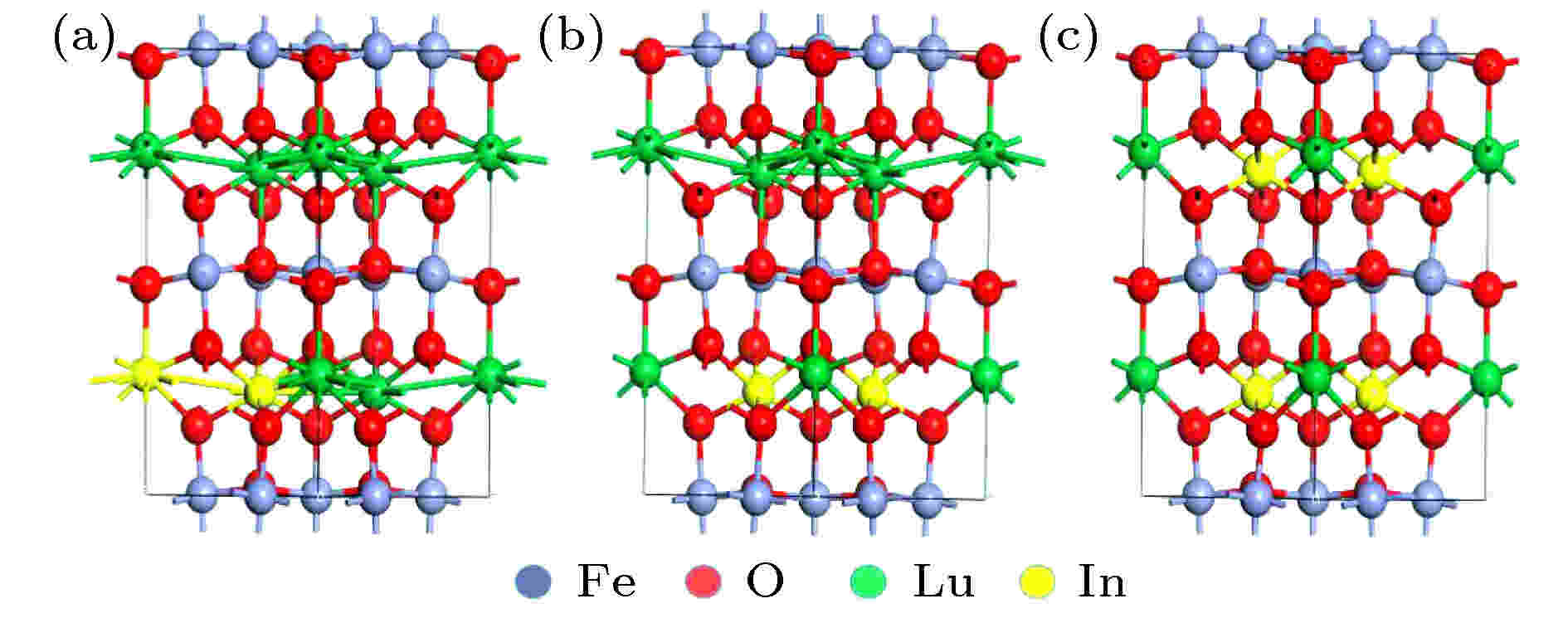
2021, 70 (3): 037101.
doi: 10.7498/aps.70.20201287
Abstract +
The h-LuFeO3 is a kind of narrow band gap hexagonal ferrite material, with a good application prospect in the field of ferroelectric photovoltaic. However, the low polarization intensity of h-LuFeO3 makes the recombination rate of photogenerated electrons and holes large, which is not conducive to the improvement of the efficiency of h-LuFeO3-based ferroelectric photovoltaic cells. In order to improve the ferroelectricity and optical absorption properties of h-LuFeO3, the first principles method is used to calculate the doping formation energy values of In atom at different positions of h-LuFeO3, and the most stable doping position is determined. The comparisons of band gap, optical absorption performance and polarization intensity among h-Lu1-xInxFeO3 (x = 0, 0.167, 0.333, 0.667) are made. With the increase of In doping, the cells of h-Lu1–xInxFeO3 stretch along the c-axis. The ratio of the lattice constant c/a increases from 1.94 at x = 0 to 2.04 at x = 0.667 when all the positions of In replace P1 position. Using the qualitative calculation of Berne effective charge, the results show that the ferroelectric polarization intensity of h-LuFeO3, h-Lu0.833In0.167FeO3, h-Lu0.667In0.333FeO3 and h-Lu0.333In0.667FeO3 along the c-axis are 3.93, 5.91, 7.92, and 11.02 μC·cm–2, respectively. Therefore, with the increase of the number of In atoms replacing Lu atoms, the lattice constant c/a ratio of h-Lu1–xInxFeO3 increases, which can improve the ferroelectric polarization strength of the material. By analyzing the density of states of h-LuFeO3 and h-Lu0.333In0.667FeO3, we can see that In doping enhances the Fe-O orbital hybridization in h-Lu0.333In0.667FeO3, and makes the optical absorption coefficient of h-Lu0.333In0.667FeO3 in the solar light range larger. In summary, In doped h-LuFeO3 is an effective method to improve its polarization intensity and optical absorption coefficient, which is of great significance for improving the performance of ferroelectric photovoltaic.
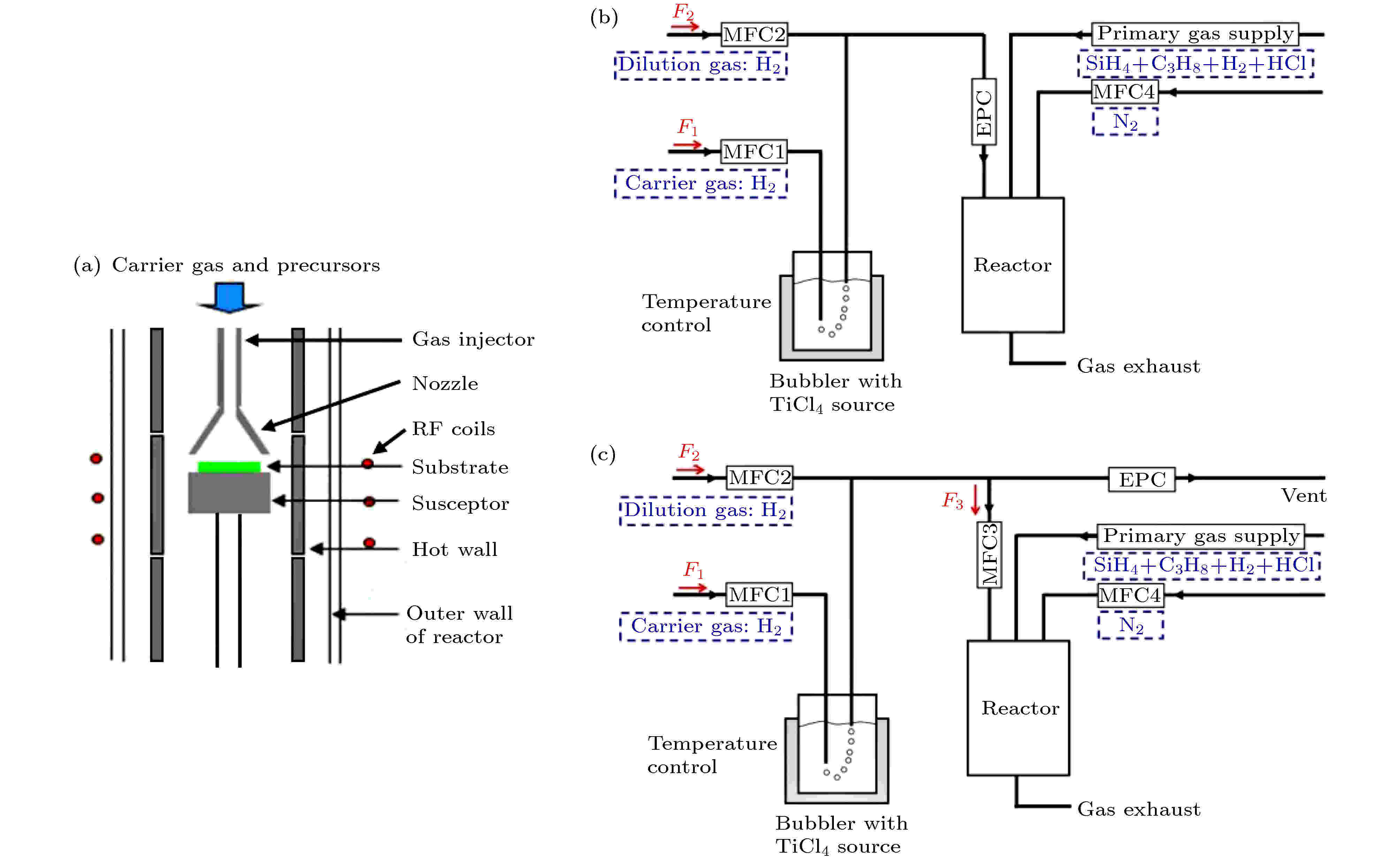
2021, 70 (3): 037102.
doi: 10.7498/aps.70.20200921
Abstract +
“Bipolar degradation” phenomenon has severely impeded the development of 4H-SiC bipolar devices. Their defect mechanism is the expansion of Shockley-type stacking faults from basal plane dislocations under the condition of electron-hole recombination. To suppress the “bipolar degradation” phenomenon, not only do the basal plane dislocations in the 4H-SiC drift layer need eliminating, but also a recombination-enhancing buffer layer is required to prevent the minority carriers of holes from reaching the epilayer/substrate interface where high-density basal plane dislocation segments exist. In this paper, Ti and N co-doped 4H-SiC buffer layers are grown to further shorten the minority carrier lifetime. Firstly, the dependence of Ti doping concentration on TiCl4 flow rate in 4H-SiC epilayers is determined by using single-dilution gas line and double-dilution gas line. Then the p+ layer and p++ layer in PiN diode are obtained by aluminum ion implantation at room temperature and 500 ℃ followed by high temperature activation annealing. Finally, 4H-SiC PiN diodes with a Ti, N co-doped buffer layer are fabricated and tested with a forward current density of 100 A/cm2 for 10 min. Comparing with the PiN diodes without a buffer layer and with a buffer layer only doped with high concentration of nitrogen, the forward voltage drop stability of those diodes with a 2 μm-thick Ti, N co-doped buffer layer (Ti: 3.70 × 1015 cm–3 and N: 1.01 × 1019 cm–3) is greatly improved.

COVER ARTICLE
2021, 70 (3): 037401.
doi: 10.7498/aps.70.20201291
Abstract +
The YBa2Cu3O7–δ (YBCO) step-edge Josephson junction on MgO substrate has recently been shown to have important applications in making advanced high-transition temperature (high-TC) superconducting devices such as high-sensitivity superconducting quantum interference device (SQUID), superconducting quantum interference filter, and THz detector. In this paper, we investigate the fabrication and transport properties of YBCO step-edge junction on MgO substrate. By optimizing the two-stage ion beam etching process, steps on MgO (100) substrates are prepared with an edge angle θ of about 34°. The YBCO step-edge junctions are then fabricated by growing the YBCO thin films with a pulsed laser deposition technique and subsequent traditional photolithography. The resistive transition of the junction shows typical foot structure which is well described by the Ambegaokar-Halperin theory of thermally-activated phase slippage for overdamped Josephson junctions. The voltage-current curves with temperature dropping down to 77 K exhibit resistively shunted junction behavior, and the Josephson critical current density JC is shown to follow the $(T_{\rm C}-T)^2$ dependence. At 77 K, the JC of the junction reaches 1.4 × 105 A/cm2, significantly higher than the range of 103–104 A/cm2 as presented by other investigators for YBCO step-edge junctions on MgO substrate with comparable θ of 35°–45°. This indicates a rather strong Josephson coupling of the junction, and by invoking the results of YBCO bicrystal junctions showing similar values of JC, it is tentatively proposed that the presently fabricated junction might be described as an S-s′-S junction with s′ denoting the superconducting region of depressed TC in the vicinity of the step edge or as an S-N-S junction with N denoting a very thin non-superconducting layer. By incorporating the MgO-based YBCO step-edge junction, high-TC radio frequency (RF) SQUID is made. The device shows decent voltage-flux curve and magnetic flux sensitivity of 250 $ \text{μ}\Phi_0/{\rm Hz}^{1/2} $ at 1 kHz and 77 K, comparable to the values reported in the literature. To further improve the RF SQUID performance, efforts could be devoted to optimizing the junction parameters such as the junction JC. By using the YBCO step-edge junction on MgO substrate, high-TC direct current SQUID could also be developed, as reported recently by other investigators, to demonstrate the potential of MgO-based step-edge junction in making such a kind of device with superior magnetic flux sensitivity.

2021, 70 (3): 037801.
doi: 10.7498/aps.70.20201271
Abstract +
As a new family member of two-dimensional materials, black phosphorus has attracted much attention due to its infrared band gap and strongly anisotropic properties, bringing new concepts and applications in different fields. In characterizing black phosphorus, optical method and electrical method are typically used to obtain structural information and fundamental properties in terms of behaviors of electrons. So far, more studies are still needed to understand in depth the physical principle and facilitate applications. In this paper, multilayered black phosphorus flakes are synthesized via mechanical exfoliation from the bulk crystal, and field-effect transistors based on few-layer black phosphorus are fabricated by micro-nano fabrication technology, which owns 0°–360° four pairs of symmetrical electrodes. We experimentally obtain the characteristics of Raman modes ${\rm{A}}_{\rm{g}}^{\rm{1}}$ , $ {\rm B_{2g}} $ , and ${\rm{A}}_{\rm{g}}^2$ in parallel (XX) and vertical (XY) polarization configuration. Furthermore, the angle-dependent source-drain current angle is measured through a BP field-effect transistor. The Raman spectrum results demonstrate that three characteristic peaks are located at 361, 439 and 467 cm–1 in a range of 200–500 cm–1, corresponding to the vibration modes of ${\rm{A}}_{\rm{g}}^{\rm{1}}$ , $ {\rm B_{2g}}, $ and ${\rm{A}}_{\rm{g}}^2$ , respectively. The fitting experimental data of polarization-dependent Raman spectra also show that the intensity for each of the three characteristic peaks has a 180° periodic variation in a parallel polarization configuration and also in a vertical polarization configuration. The maximum Raman intensity of Ag is along the AC direction, while that of B2g is along the ZZ direction. On the other hand, the electric transport curves illustrate that the largest source leakage current can be obtained near 0° (180°) armchair direction. Such results indicate the anisotropy of black phosphorus. Furthermore, transfer curves with different electrode angles show that the weak bipolarity of black phosphorus at 45° (225°), 90° (270°), and p-type performance at 0° (180°), 135° (315°) can be offered, respectively. This work is conducive to studying the properties and practical applications of devices based on black phosphorus.
INTERDISCIPLINARY PHYSICS AND RELATED AREAS OF SCIENCE AND TECHNOLOGY
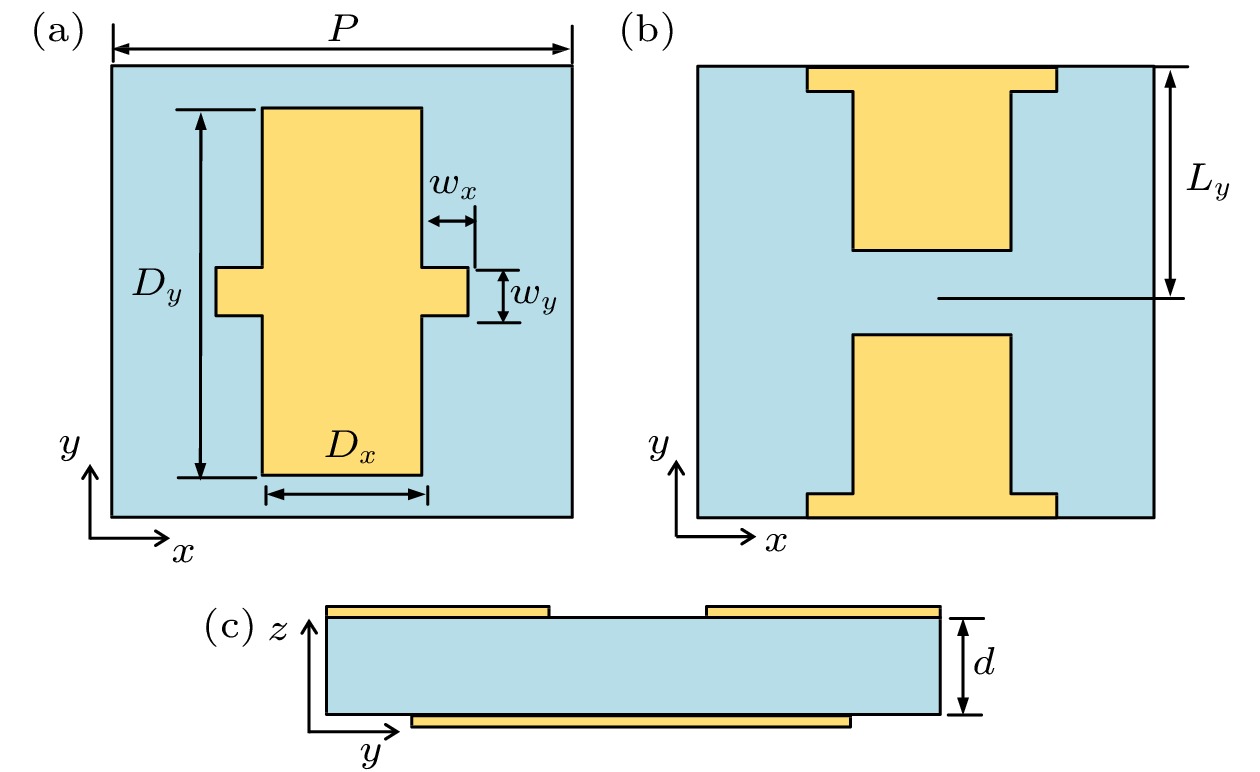
2021, 70 (3): 038101.
doi: 10.7498/aps.70.20200975
Abstract +
A broadband and high-efficieny bi-layer metasurface is proposed in this paper. The unit cell of the metasurface is formed by symmetrically etching two cross-type metal patches on both sides of a dielectric plate. Furthermore, the two metal patches have a displacement of half a period along the y-axis. By employing the displacement, the transmission bandwidth of the bi-layer metasurface is significantly expanded. In order to obtain a physical insight into bandwidth broadening, a π-type equivalent circuit that presents the electromagnetic coupling between within the bi-layer metasurfaces is successfully extracted to investigate the influence of electromagnetic coupling on transmission performance. The results show that by shifting the metal patches along the y-axis by half a period, the coupling impedance (Z12 or Z21) of bi-layer metasurface can be significantly modified, which further changes the electromagnetic coupling of the bi-layer metasurface. Correspondingly, the impedances Zp and Zs in the π-type circuit are changed to approximately meet the resonant condition of circuit in broadband, resulting in the bandwidth expansion of the proposed device. By using Pancharatnam-Berry phase theory, we redesign the proposed metasurface unit cell into a broadband orbital angular momentum generator. The simulation and measurement results verify that the bi-layer metasurface can convert a left-hand circularly polarized wave into a right-hand circularly polarized wave carrying orbital angular momentum in a frequency range between 11 GHz and 12.8 GHz, demonstrating the performance of device.
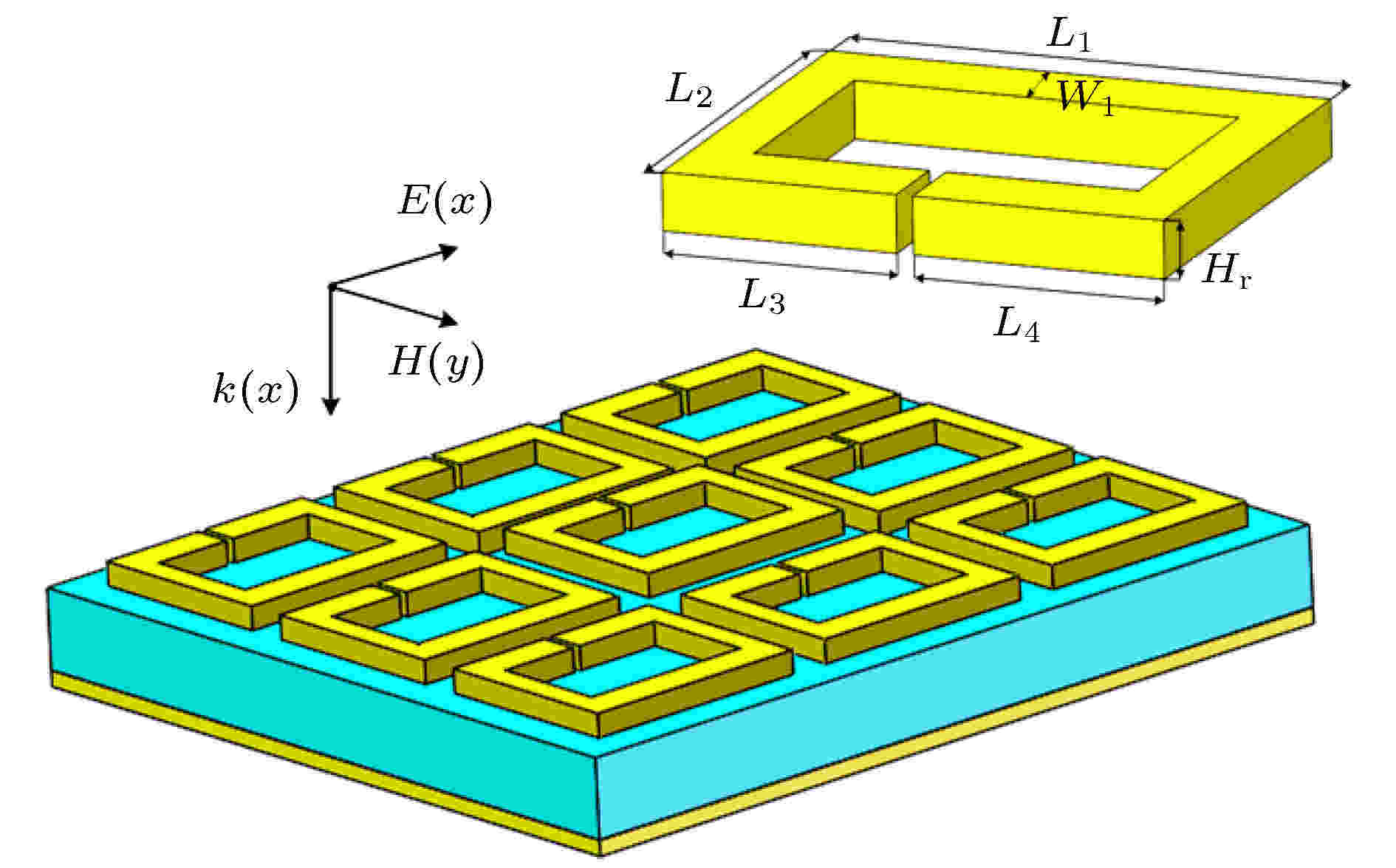
2021, 70 (3): 038102.
doi: 10.7498/aps.70.20201054
Abstract +

EDITOR'S SUGGESTION
2021, 70 (3): 038103.
doi: 10.7498/aps.70.20201134
Abstract +
In recent years, due to the shortage of fossil energy and environmental pollution, the harvesting and conversion of solar energy using semiconductors has attracted more and more attention. Among many kinds of traditional semiconductor photocatalysts, the titanium dioxide (TiO2) has become one of the most popular semiconductor photocatalysts because of its low cost, good stability and environmental friendliness. However, TiO2 has a relatively wide band gap (i.e., 3.2 eV for anatase and 3.0 eV for rutile), which can only absorb ultraviolet light with a wavelength less than 387 nm, and has a low utilization rate of sunlight. Moreover, the photo-generated electron-hole pairs in the system of TiO2 film and particle are easy to recombine, which makes the photocatalytic efficiency of the material relatively low. In order to solve these problems, TiO2 structure with porous (such as nanotube) is used to restrain the recombination of photo-generated electron-hole pairs due to its large specific surface area and good charge transfer characteristics, thereby improving its photocatalytic efficiency. In addition to changing the structure of traditional semiconductor materials, using the surface plasmon resonance effect of metal micro-nano structures to improve its photoelectric conversion efficiency has many potential applications in the fields of photovoltaic, photocatalysis and photoelectric detection. In this paper, we prepare different metallic nanoparticles loaded TiO2 nanotube composite structures by atomic layer deposition method and electron beam thermal evaporation technology and investigate the photocatalytic properties of the composite structures. It is shown that comparing with the pure TiO2 nanotubes, the photocurrent of TiO2 nanotubes loaded with Au nanoparticles increases by about 400% under 568 nm visible light irradiation; the photocurrent of TiO2 nanotubes loaded with Al nanoparticles increases by about 50% under 365 nm ultraviolet (UV) irradiation; the photocurrent of TiO2 nanotubes loaded with bimetallic Au and Al nanoparticles increases by about 50% in the whole UV-visible light region: it is significantly enhanced. Based on the fact that the surface plasmon resonance frequency of Au and Al nanoparticles are complementary, not only is the optical absorption of TiO2 nanotubes enhanced and broadened, but also the photocurrent is enhanced from ultraviolet to visible light. We believe that these results will contribute to the further development of photocurrent in semiconductor nanotubes.

2021, 70 (3): 038401.
doi: 10.7498/aps.70.20201336
Abstract +
The relativistic klystron amplifier (RKA) is one of the most efficient sources to amplify a high-power microwave signal due to its intrinsic merit of high-power conversion efficiency, high gain and stable operating frequency. However, the transverse dimensions of the RKA dramatically decrease when the operating frequency increases to X band, and the power capacity of the RKA is limited by the transverse dimensions. An X-band multiple-beam relativistic klystron amplifier is proposed to overcome the radiation power limitation. Each electron beam propagates in separate drift tubes and shares the same coaxial interaction cavities in the multiple-beam relativistic klystron amplifier, and the transverse dimensions of the multiple-beam relativistic klystron amplifier are free from the operating frequency restriction and a microwave power of over 1 GW is generated in the experiment. For a high-power electron device, the transmission of electron beam is critical, and the power conversion efficiency of the device is affected. In this paper, we conduct an investigation into the transmission process of the intense relativistic multiple electron beams, and the number of the multiple electron beams is set to be 16. It is found that when the multiple electron beam is transmitted in the device, the electron beam rotates around the center of the whole device, causing the electron beam to deviate from the drift tube channel. At the same time, each electron beam rotates around itself, and the cross section of the electron beam is deformed and expanded. In the improper design of electron beam and drift tube parameters, two kinds of rotating motions cause beam to lose. A multiple-electron-beam diode structure is optimized by the particle-in-cell simulation to reduce beam loss, with the effects of the related factors taken into account. Each pole of the cathodes is made up of graphite and stainless steel. The cathode head is made up of graphite, for the graphite has a lower emission threshold. The cathode base and cathode pole are made up of stainless steel, for the stainless steel has a higher emission threshold. Also the shape and structure of cathode pole, cathode head and anode are optimized to reduce the electric field intensity on the cathode pole and enhance the electric field intensity on the end face of cathode head. At the same time, the electric field distribution of the cathode head is uniform to improve the electron beam emission uniformity. The simulation results demonstrate that the transmission efficiency of multiple electron beams can reach 99%. In the experiment, the transmission efficiency of multiple electron beams is 92% with a beam voltage and beam current of 801 kV and 9.3 kA, respectively.

2021, 70 (3): 038402.
doi: 10.7498/aps.70.20201475
Abstract +
Compressed sensing is a revolutionary signal processing technique, which allows the signals of interest to be acquired at a sub-Nyquist rate, meanwhile still permitting the signals from highly incomplete measurements to be reconstructed perfectly. As is well known, the construction of sensing matrix is one of the key technologies to promote compressed sensing from theory to application. Because the Toeplitz sensing matrix can support fast algorithm and corresponds to discrete convolution operation, it has essential research significance. However, the conventional random Toeplitz sensing matrix, due to the uncertainty of its elements, is subject to many limitations in practical applications, such as high memory consumption and difficulty of hardware implementation. To avoid these limitations, we propose a bipolar Toeplitz block-based chaotic sensing matrix (Bi-TpCM) by combining the intrinsic advantages of Toeplitz matrix and bipolar chaotic sequence. Firstly, the generation of bipolar chaotic sequence is introduced and its statistical characteristics are analyzed, showing that the generated bipolar chaotic sequence is an independent and identically distributed Rademacher sequence, which makes it possible to construct the sensing matrix. Secondly, the proposed Bi-TpCM is constructed, and it is proved that Bi-TpCM has almost optimal theoretical guarantees in terms of the coherence, and also satisfies the restricted isometry condition. Finally, the measurement performances on one-dimensional signals and images by using the proposed Bi-TpCM are investigated and compared with those of its counterparts, including random matrix, random Toeplitz matrix, real-valued chaotic matrix, and chaotic circulant sensing matrix. The results show that Bi-TpCM not only has better performance for these testing signals, but also possesses considerable advantages in terms of the memory cost, computational complexity, and hardware realization. In particular, the proposed Bi-TpCM is extremely suitable for the compressed sensing measurement of linear time-invariant (LTI) systems with multiple inputs and single output, such as the joint parameter and time-delay estimation for finite impulse response. Moreover, the construction framework of the proposed Bi-TpCM can be extended to different chaotic systems, such as Logistic or Cat chaotic systems, and it is also possible for the proposed Bi-TpCM to derive the Hankel blocks, additional stacking of blocks, partial circulant blocks sensing matrices. With these block-based sensing architectures, we can more easily implement compressed sensing for various compressed measurement problems of LTI systems.

2021, 70 (3): 038501.
doi: 10.7498/aps.70.20201095
Abstract +
With the development of microelectronics and the miniaturization of electronic devices, the use of molecular materials to construct various components in electronic circuits has become a most likely development trend. Compared with silicon-based semiconductor components, molecular electronic device has the advantages of small size, high integration, low energy consumption and fast response. In recent years, more and more molecules have been used to design molecular devices such as molecular diodes, molecular switches, molecular field effect transistors and molecular memories. In this paper, sandwich structure devices based on graphene nanoribbon electrodes are constructed. The first-principles calculation method combining density functional theory and non-equilibrium Green’s function is adopted to design the molecular devices with functional characteristics. The effects of redox reactions on the electrical transport properties of molecular devices are systematically discussed. The main research contents of this paper are as follows. The switching characteristics of an anthraquinone molecular device based on graphene electrode are studied. The zigzag-edge nanoribbons and armchair-edge graphene nanoribbons are selected as electrodes. Considering the two isomers of anthraquinone (HQ) and anthraquinone (AQ) molecules in the redox reaction, the double electrode molecular junction is constructed. The effects of redox reaction and electrode structure on the switching characteristics of anthraquinone molecular devices are discussed. It is found that the current in the HQ configuration is significantly greater than that in the AQ configuration, regardless of the zigzag-edge graphene electrode or the armchair-edge graphene electrode. That is, under the redox reaction, the anthraquinone molecules show significant switching characteristics. The switching ratio of zigzag-edge graphene electrode is selected to reach a maximum of 3125, and that of armchair-edge graphene electrode is selected to maximum of 1538. In addition, when the armchair-edge graphene is used as an electrode in the HQ configuration, the negative differential resistance is obviously between 0.7 and 0.9 V.
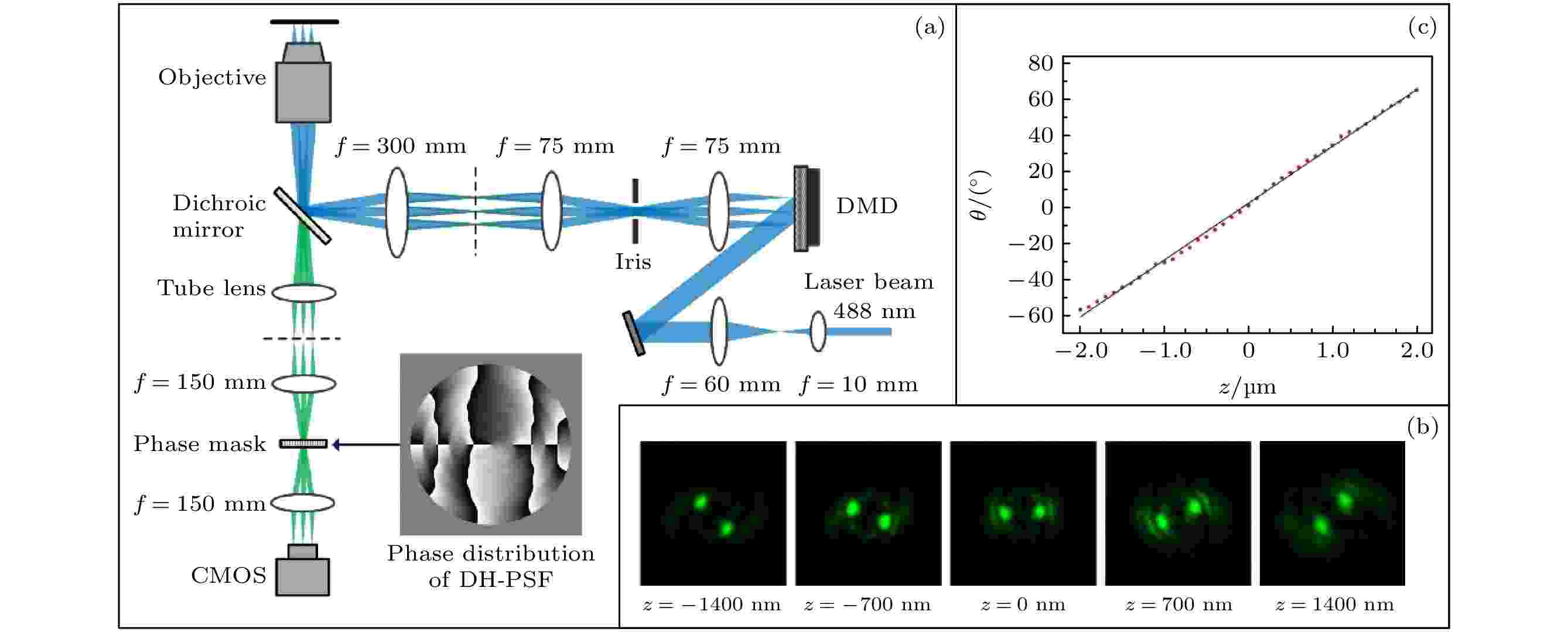
2021, 70 (3): 038701.
doi: 10.7498/aps.70.20200640
Abstract +
Confocal laser scanning microscopy (CLSM) is a powerful imaging tool providing high resolution and optical sectioning. In its standard optical configuration, a pair of confocal pinholes is used to reject out-of-focus light. The diffraction limited resolution can be broken by reducing the confocal pinhole size. But this comes at the cost of extremely low signal-to-noise ratio (SNR). The limited SNR problem can be solved by image scanning microscopy (ISM), in which the single-point detector of a regular point-scanning confocal microscopy is substituted with an array detector such as CCD or CMOS, thus the two-fold super-resolution imaging can be achieved by pixel reassignment and deconvolution. However, the practical application of ISM is challenging due to its limited image acquisition speed. Here, we present a hybrid microscopy technique, named multifocal refocusing after scanning using helical phase engineering microscopy (MRESCH), which combines the double-helix point spread function (DH-PSF) engineering with multifocal structured illumination to dramatically improve the image acquisition speed. In the illumination path, sparse multifocal illumination patterns are generated by a digital micromirror device for parallel imaging information acquisition. In the detection path, a phase mask is introduced to modulate the conventional PSF to the DH-PSF, which provides volumetric information, and meanwhile, we also present a digital refocusing strategy for processing the collected raw data to recover the wild-filed image from different sample layers. To demonstrate imaging capabilities of MRESCH, we acquire the images of mitochondria in live HeLa cells and make a detailed comparison with those from the wide-field microscopy. In contrast to the conventional wide-field approach, the MRESCH can expand the imaging depth in a range from –1 μm to 1 μm. Next, we sample the F-actin of bovine pulmonary artery endothelial cells to characterize the lateral resolution of the MRESCH. The results show that the MRESCH has a better resolution capability than the conventional wide-field illumination microscopy. Finally, the proposed image scanning microscopy can record three-dimensional specimen information from a single multi-spot two-dimensional scan, which ensures faster data acquisition and larger field of view than ISM.
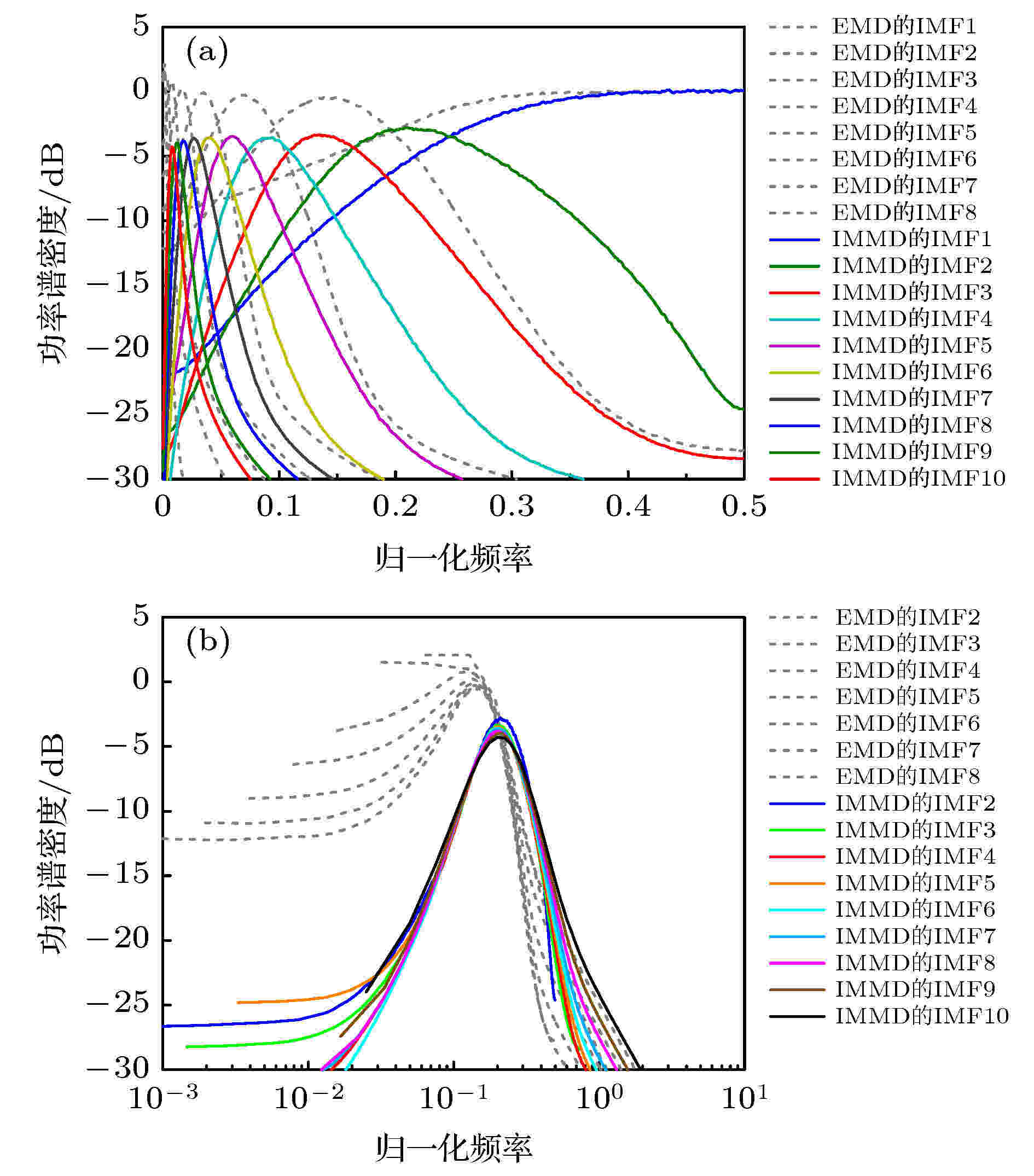
2021, 70 (3): 038702.
doi: 10.7498/aps.70.20201122
Abstract +
Electrocardiogram (ECG) diagnosis is based on the waveform, duration and amplitude of characteristic wave, which are required to have a high accuracy for ECG signal reconstruction. As an effective nonlinear signal processing method, empirical mode decomposition (EMD) has been widely used for diagnosing and reconstructing the ECG signal, but there are two problems arising here. One is the mode mixing, and the other is that the mode components used in reconstruction are identified by experience. Therefore, the method of reconstruction is not adaptive and universal, and reconstructed ECG signal loses accuracy. Firstly, we propose an improved EMD method, which is called integral mean mode decomposition (IMMD). The analysis of 5000 samples of Gaussian white noise shows that IMMD has better multi-resolution analysis ability than EMD, and it can effectively alleviate mode mixing consequently. Secondly, based on the inherent physical characteristics of ECG signal, cardiac cycle or heart rate (HR), it has practical physical significance to identify the mode components used in ECG signal reconstruction. The cardiac cycle feature acts as the intrinsic mode function (IMF) component through two modes. 1) For the low-order IMF that belongs to the ECG signal, the cardiac cycle feature acts as the amplitude modulation. The envelope of the IMF component has the characteristics of the cardiac cycle, and the frequency corresponding to the maximum amplitude in the spectrum of the envelope is equal to HR. 2) For the high-order IMF that belongs to the ECG signal, the cardiac cycle feature acts as frequency modulation. Those IMF components have the harmonic characteristics of periodic heartbeats, and the maximum amplitude in the spectrum corresponds to an integral multiple of HR (usually 1-3 times). The noise attributed to IMF component cannot show the above two cardiac cycle characteristics. Thus the proposed method is adaptive and universal. The 47 ECG signals with baseline drift and muscle artifact noise are tested. The results show that the proposed method is more effective than the variational mode decomposition (VMD), Haar wavelet with soft threshold, ensemble empirical mode decomposition (EEMD) and EMD. Among the 47 correlation coefficients between reconstructed and original ECG signals, the proposed method has 31 better than VMD, 33 better than Haar wavelet, 42 better than EEMD and 45 better than EMD. The mean of 47 correlation coefficients from the proposed method is 0.8904, and the variance is 0.0071, which shows that the proposed method has good performance and stability.
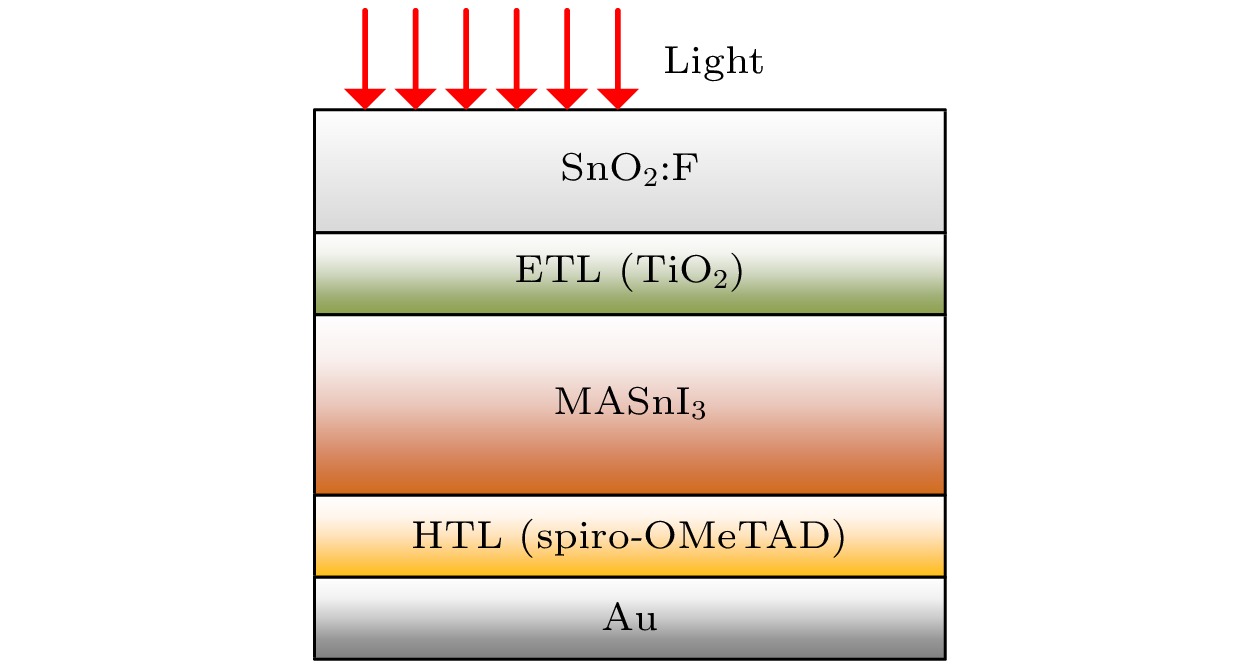
2021, 70 (3): 038801.
doi: 10.7498/aps.70.20201219
Abstract +
To avoid environmental pollution caused by lead, the tin-based perovskite solar cells have become a research hotspot in the photovoltaic field. Numerical simulations of tin-based perovskite solar cells are conducted by the solar cell simulation software, SCAPS-1D, with different electron transport layers and hole transport layers. And then the performances of perovskite solar cells are compared with each other and analyzed on different carrier transport layers. The results show that band alignment between the carrier transport layer and the perovskite layer are critical to cell performances. A higher conduction band or electronic quasi-Fermi level of electron transport layer can lead to a higher open circuit voltage. Similarly, a lower valence band or hole quasi-Fermi level of hole transport layer can also promote a higher open circuit voltage. In addition, when the conduction band of electron transport layer is higher than that of the absorber, a spike barrier is formed at the interface between the electron transport layer and perovskite layer. Nevertheless, a spike barrier is formed at the interface between the perovskite layer and the hole transport layer if the valence band of hole transport layer is lower than that of the absorber. However, if the conduction band of electron transport layer is lower than that of the absorber or the valence band of hole transport layer is higher than that of the absorber, a cliff barrier is formed. Although the transport of carrier is hindered by spike barrier compared with cliff barrier, the activation energy for carrier recombination becomes lower than the bandgap of the perovskite layer, leading to the weaker interface recombination and the better performance. Comparing with other materials, satisfying output parameters are obtained when Cd0.5Zn0.5S and MASnBr3 are adopted as the electron transport layer and the hole transport layer, respectively. The better performances are obtained as follows: Voc = 0.94 V, Jsc = 30.35 mA/cm2, FF = 76.65%, and PCE = 21.55%, so Cd0.5Zn0.5S and MASnBr3 are suitable carrier transport layer materials. Our researches can help to design the high-performance tin-based perovskite solar cells.







































